|
| |
|
|
The photo
caption on the right now refers to Master Otter, f.k.a.
Buddy, now is
"Otto."
Below, Pat
is referred to only as "the big brown bear." The
constant pacing is a sign of a mental stress due to
repeated attempts to deal with a problem-- Like
confinement in an insufficient living space.
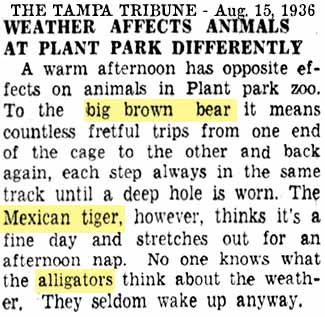 |
 |
|
TOURIST REGISTRATION
& INFORMATION CENTER
The tourist registration/information center at Plant Park
was located near the entrance of Lafayette St. It also served as the park office where the horned toad was first kept.
Jan. 10, 1936 Burgert Bros. photo courtesy of the Tampa-Hillsborough Co.
Public Library System.
|
|
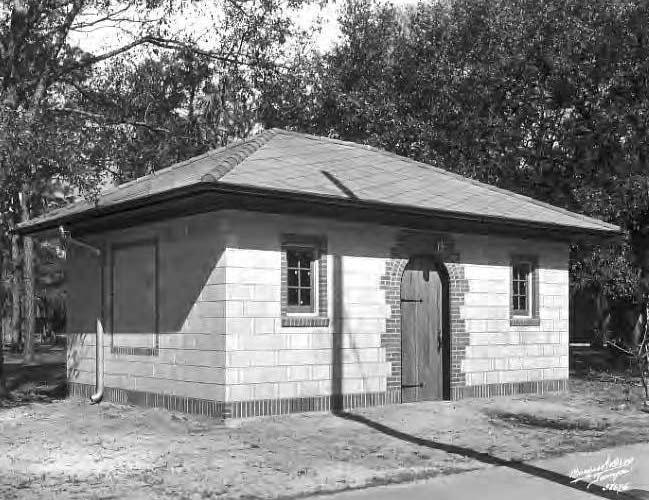 |
| |
Sept. 4, 1936 Burgert Bros. photos
courtesy of the Tampa-Hillsborough Co. Public Library System.
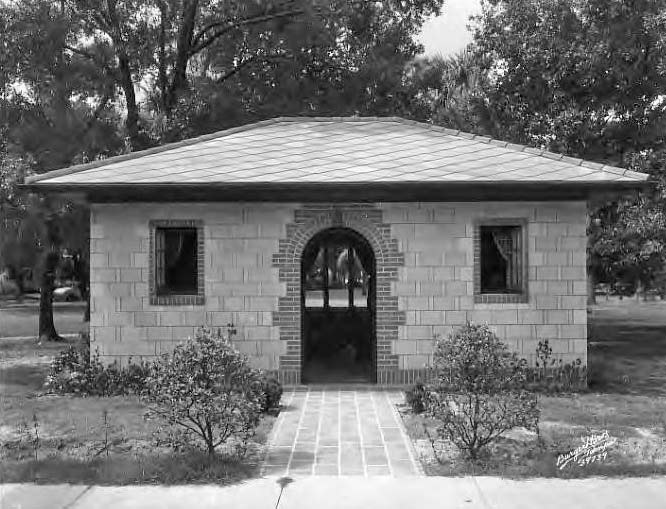
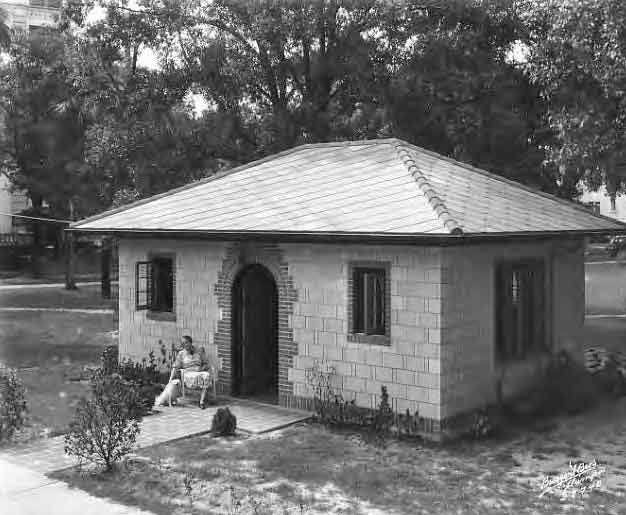 |
|
THE BEAR CAVE
This
appears to be Pat, based on the appearance of Pat in the
previous photo of Jul. 14, 1936. |
ESCAPED PLANT PARK
GATOR SHOT AT DAVIS ISLANDS |
 |
An alligator which
frequently escaped from Plant Park was seen in a canal at Davis
Islands in early Nov. 1934 by a park employee who was unable to net
him. When he was away getting help, someone fatally shot the
gator. |
|
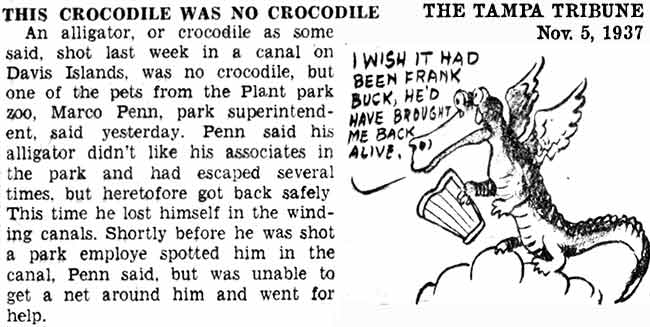 |
MARCO
PENN CREATED FIVE NEW PARKS IN PAST FOUR YEARS
A recent project
of the Parks Dept. is improvements to the zoo "where animals
shown include TWO bears, alligators and Mexican tiger."
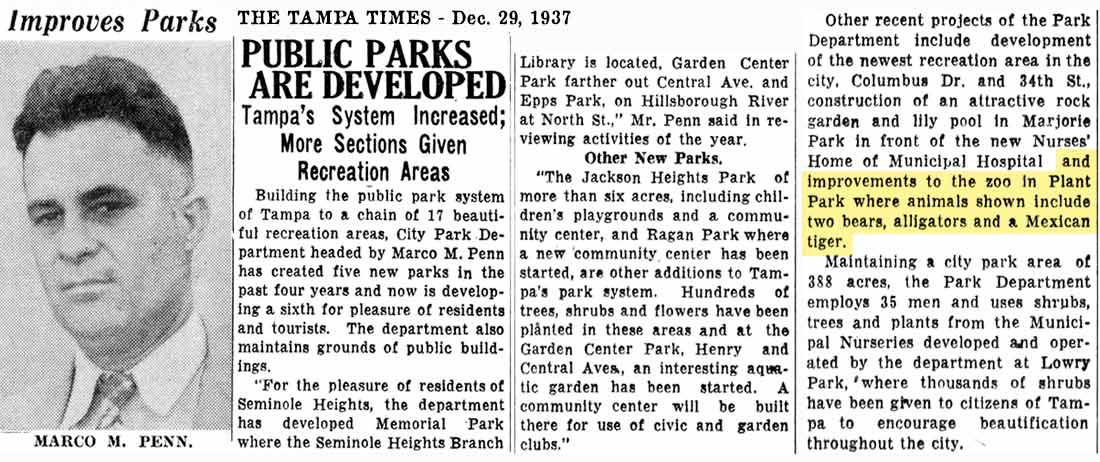
THE BEARS HAVE A BRIEF SPARRING MATCH
Pat and Suzy duke
it out.
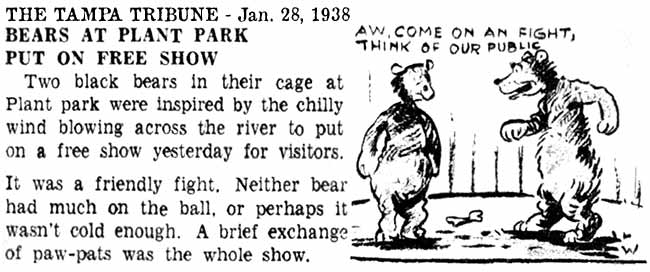
THE PLANT
PARK BEARS MENTIONED BY NAME, PAT & SUZY
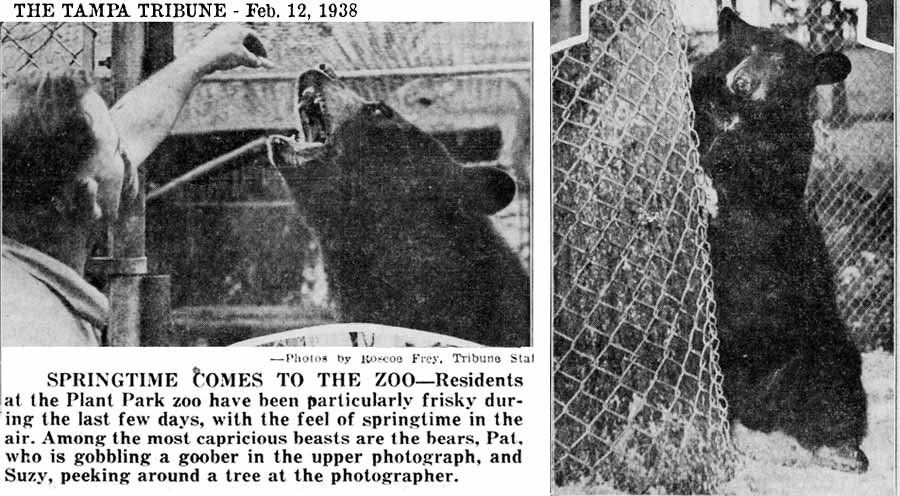
|
TURTLES ORDERED
Feb. 1938 - Marco Penn arranged with a Tarpon
Springs diver to bring 600-lb. turtles for the zoo.
He had already begun to build a big tidewater pool
near the lower end of Bear creek
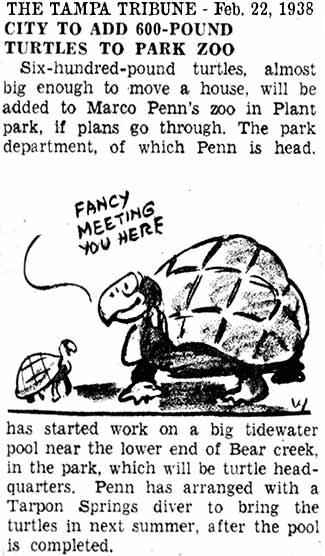 |
LIONS OFFERED FOR SALE TO ZOO
April 1938 - A Ft. Lauderdale lion farm offered the
City of Tampa two lion cubs named Wally and Edward
"at a most reasonable figure."
Mayor Chancey turned down the offer saying he didn't
think the Tampa zoo was "quite pretentious enough"
and the habitat requirements would be beyond the
City's capability.
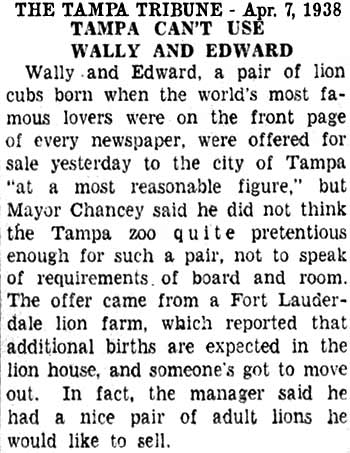
|
VISITOR SAYS BEAR HABITAT INSUFFICIENT
June 1938 - A man from Ossining, NY who spent
several weeks in Tampa wrote the Tribune with
concerns about the tight confinement of the bears.
Again, Pat is described as pacing back and forth for
about ten feet until he wore a rut in the ground.
Mr. Cornell suggests a larger cage
and asked what happened to the bird cages that were
in the park. When a visitor remarks that an
animal enclosure needs improvement, it must be
pretty bad.
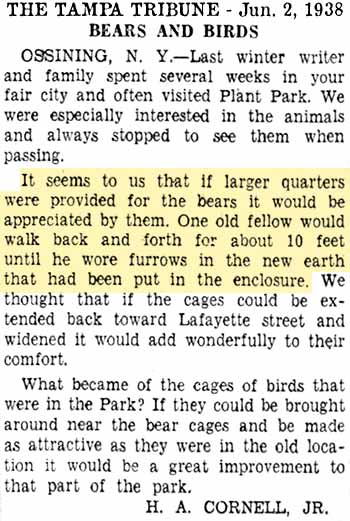 |
|
THE GATOR
THAT GOT AWAY IN 1934 IS FOUND IN 1938
It turns out that "Buck," the
alligator
that got away in the river in 1934 came back and took up
residence under the former Tampa Bay Hotel building, which had
become home to the University of Tampa in 1933. It is
believed that it was living off rats and occasionally swimming
out via the sewer into the river for fish.
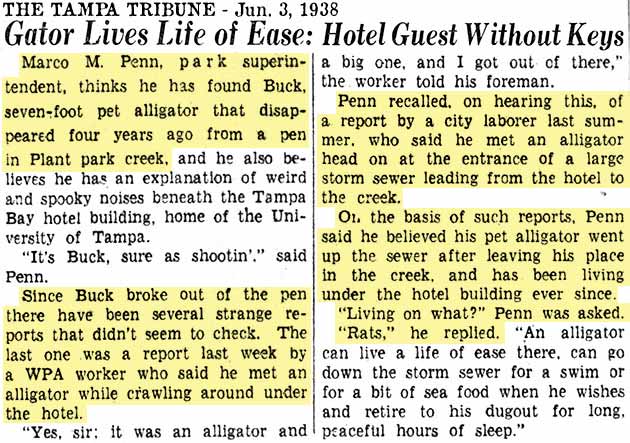
|
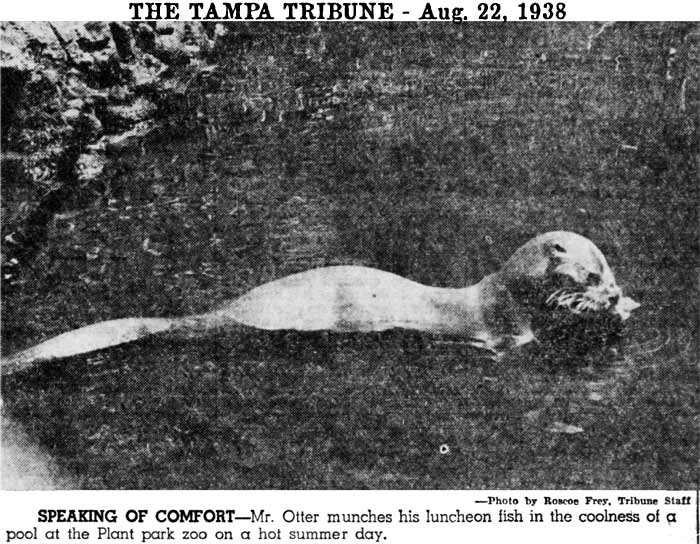
|
NO SOUP FOR TURTLE
In Sep. 1938 a 300-lb. loggerhead turtle was captured in
Old Tampa Bay and added as an exhibit at the Plant Park
Zoo. |
|
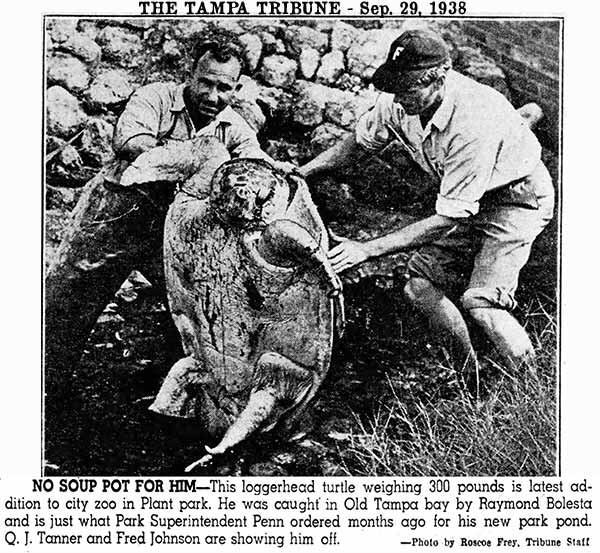 |
RATS ARE A PROBLEM IN
PLANT PARK
Dec.
1938 - Rats of all sizes infested the rock embankments
of the park stream near the river. The spaces
between the rocks provided the rats with small caves in
which to live. Visitors to the zoo seemed more
interested in watching the rats' antics than watching
the zoo animals. The rats were also stealing the
bears' food.
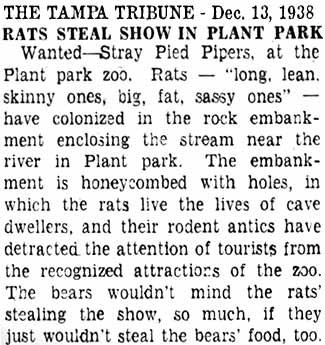
This is the last article that speaks of "bears" in
plural. |
|
GENERAL DESCRIPTION OF PLANT PARK AS A RECREATION
CENTER
Dec. 1938 -
A fine description of Plant Park is presented in
this article. It's described as the City's
largest recreational space, noted for its tropical
splendor. It was home to the old Tampa Bay
Hotel building, then the University of Tampa, the
Municipal Museum (now the Plant Museum,) the "Legion
Casino," Municipal Auditorium (later named the McKay
Auditorium, and now the business college building,)
a band shell, the zoo, and the Tampa Tourist Center. |
|
In addition to the facilities in the Tourist Center,
there were tennis courts, play-ground equipment, and
parkways with numerous rare shrubs and flowers.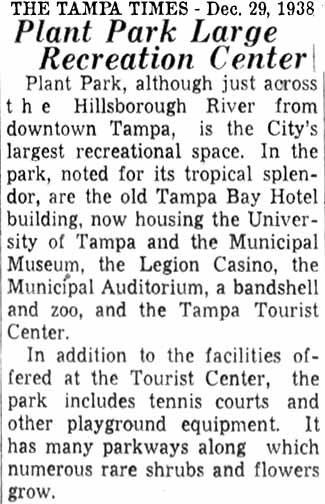 |
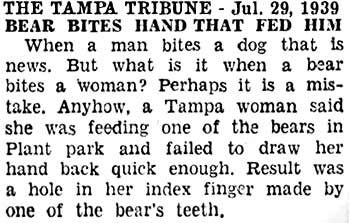
BEAR BITES WOMAN - July 29, 1939
Visitors seem to think they can feed
a bear like they hand-feed their domesticated pets.
With the press frequently endorsing feeding the
bears peanuts and often referring to them as "pet bear(s)" they can take some of the responsibility
too.
Notice
above reference is made to "one of the bears,"
implying that there was more than one.
A TIGER AND
A BEAR AT PLANT PARK
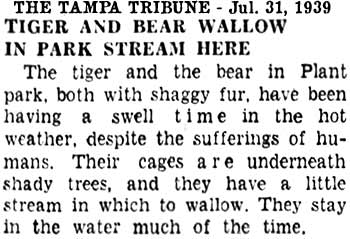
July 1939 -
Just two days after the above article, this one
mentions the bear as singular. With no news in
between concerning one bear is gone, by whatever
means, one of these can't be relied on to determine
how many bears were at the zoo at this time. This reporter thinks the tiger and bear are having a
"swell time" in the peak summer heat, despite their
shaggy fur, and that just the humans were suffering.
The reason given was that their cages were
underneath shady trees, and they had a little stream
in which to wallow.
|
|
TWO MORE BEAR
BITE INCIDENTS ABOUT A YEAR APART
Just three
months after the previous bear bite incident, this one involved children sticking their hand through
the chain-link fence opening to feed the bear. Clearly
there is no secondary barrier at the bear cage. Each time
the articles imply that there was only one bear at the
zoo by not stating "ONE of the bears..."
If there's any significance to this singular reference,
it would have been Suzy doing the biting.
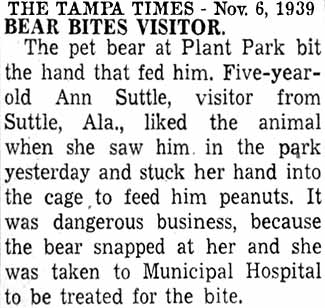
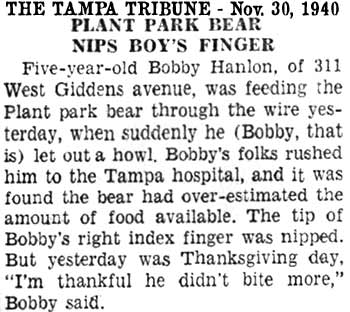
GAS
RATIONING RESULTS IN MORE STAY-CATIONS, VISITS TO
LOCAL POINTS OF INTEREST
A
Tribune reporter who is a frequent traveler tells about
the various points of interest in Tampa because travel
distance is impacted by three gallons a week rationing.
So this reporter who usually wrote about his distant
travels decided to tell about the local points of
interest such as Plant Park, fishing at the Ballast
Point pier, and the Sulphur Springs pool. For the
athletic, adventurous type, he also suggests hopping a
bicycle and riding out to Rattlesnake, Fla. on the road
to the Gandy Bridge. "There, Mayor George K. End
will show you his collection of snakes and give you the
opportunity of buying canned rattlesnake meat, in
supreme sauce, at $1.25 a can."
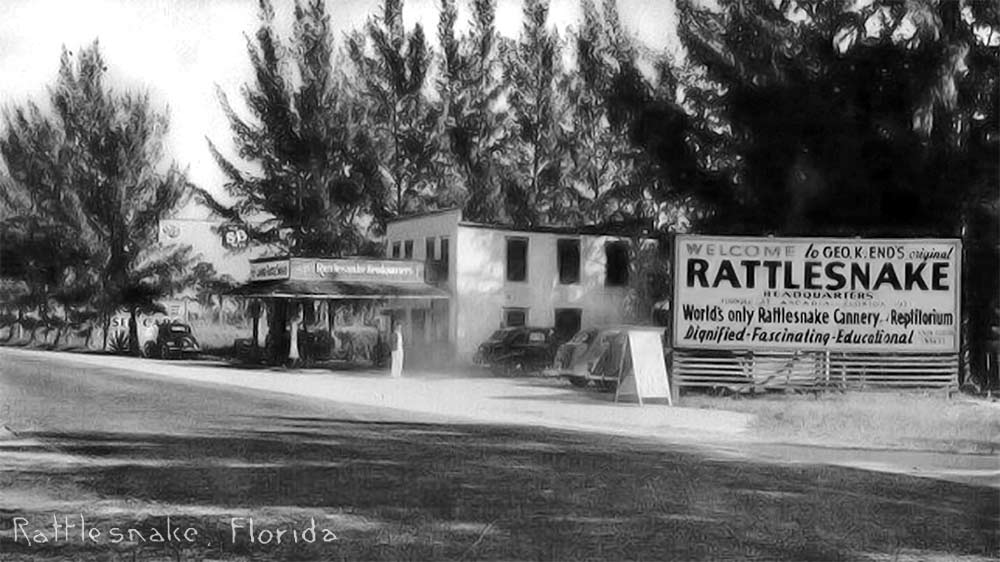
If
you still have time left after all the previous Tampa
area vacation spots, "You might try sitting on a bench
in the courthouse square and watching the goldfish in
the lily pool. It must be a fascinating diversion.
Some people have been doing it every day for years."
The article and accompanying photo mention the
bear as if the only one there. Other park mentions are
of feeding the squirrels, the University of Tampa, and
the Tampa museum. This is an excerpt showing only
the part about Plant Park.
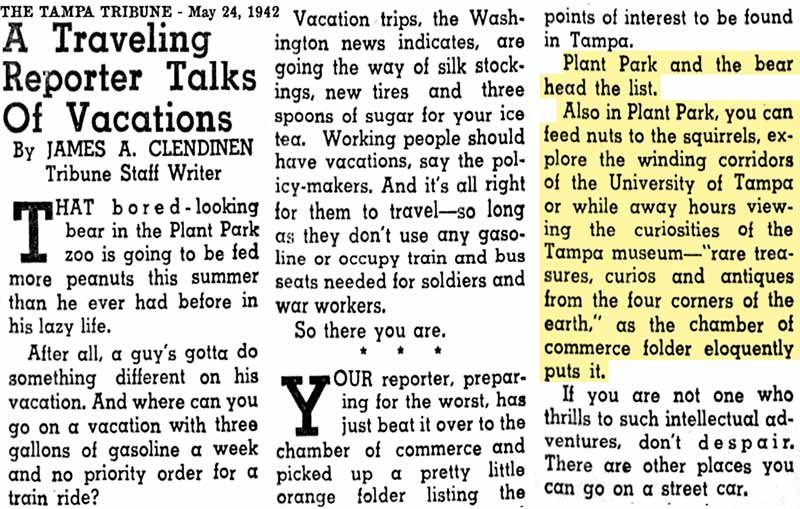 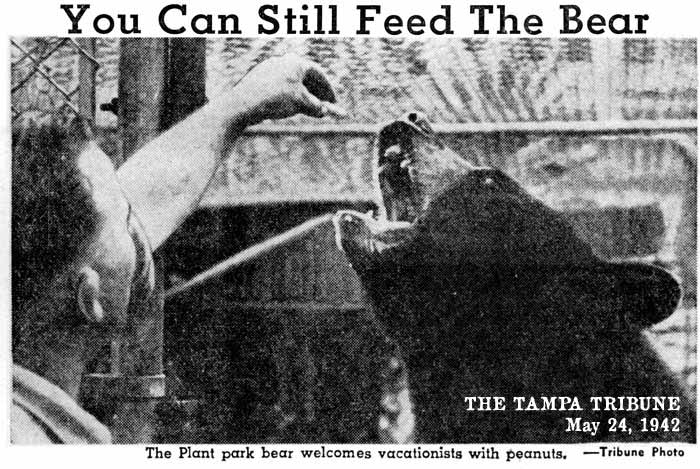

SEVEN-FOOT LONG GATOR CRAWLS FROM ESTUARY, DUBBED
"HITLER" BY A SPECTATOR
On
May 6, 1941, a seven-foot long gator made it out of the
estuary and tied up traffic at 13th St. and E. Twiggs.
The gator was hit by a truck around 9pm and within 10
minutes, a crowd claimed to be of 400 Tampans had
gathered. A sanitation truck arrived to take him
to Plant Park zoo, as scores of cars lined the street
and dozens of men and boys were poking sticks and
throwing things at him.
Two
sanitation workers tied a rope around its neck and seven
volunteers from the crowd grabbed his tail as it
viciously whipped it around and snorted. It clamped
its jaws on the tail end of the truck and ripped it
loose. By this time a Tampa police officer had
arrived, ordered the crowd back and shot the gator, at
which time someone in the crowd yelled, "There goes
Hitler!"
Had he
behaved, he would have ended up at the Plant Park zoo.
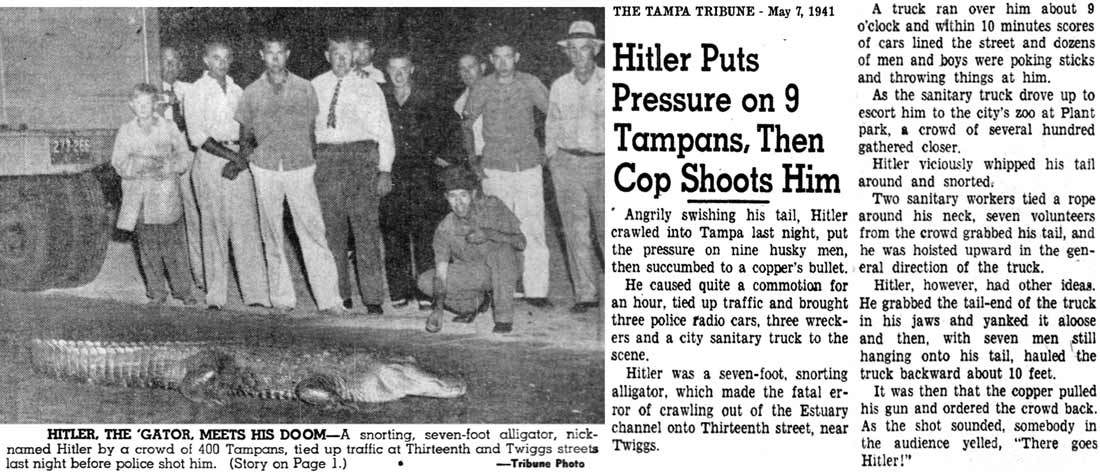 |
| |
|
|
Callie Mae (Penn)
Brown, all grown up, with her son Dickie. |
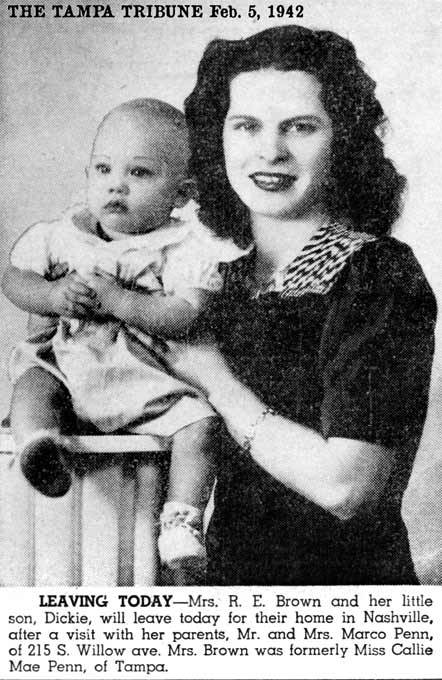 |
|
BOB, THE
MEXICAN TIGER,
IS DRAFTED INTO THE
U.S. ARMY
It's not known yet when
the Mexican tiger was officially named, but here it is said his name is
"Bob." Probably named for the mayor,
Robert E. Lee Chancey (or "bobcat"). This article mentions one bear,
the Plant Park bear as "Bruin" which is incorrect.
The bear was named Susie (or Suzie or Suzy.)
|
|
Bob was offered to Drew
Field Commander Col. Melvin B. Asp by Marco Penn because
of the rising costs of feeding him.
The article on
the right says Penn had been complaining about the
gasoline to took to drive around for Bob's meat.
Notice that Bob was kept in an "elevated house over the
creek, next door to Bruin, the bear."
The photo
shows several men attempting to move that "elevated
house."
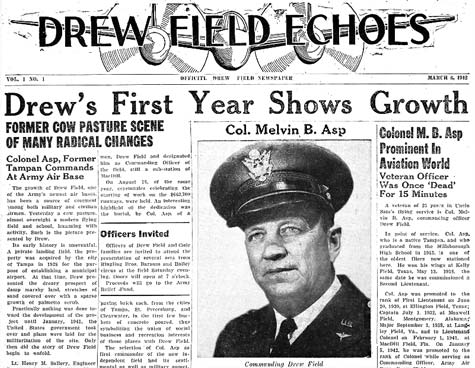
Melvin Asp was a Hillsborough High School graduate.
Mar. 6 1942 Drew Field newspaper courtesy of
UF Digital Military Newspaper collection.
Bob was taken to the "new
recreation park" at Drew Field, where he will be the
field mascot. A concrete house and heavy wire pen
was to be built for him, and plans were to feed him
"plenty of meat scraps and fish heads."
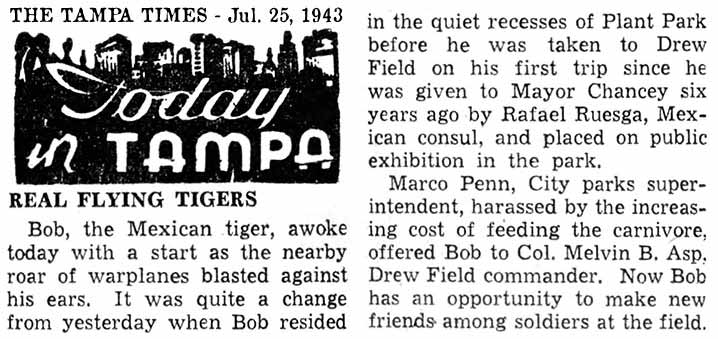 |
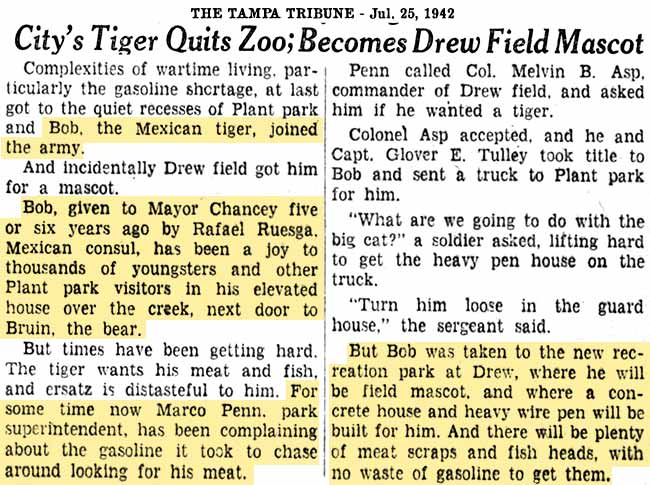
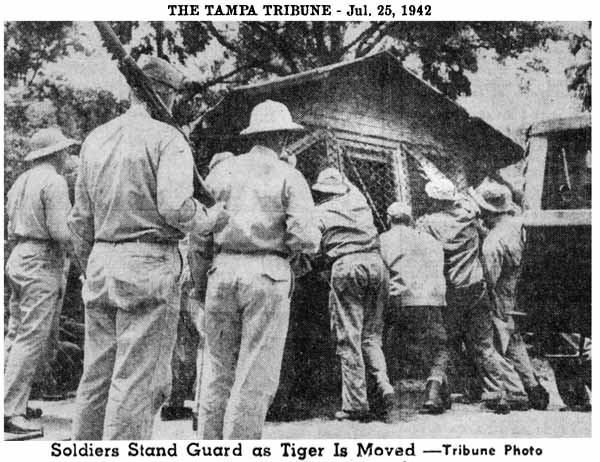
Two
years of Drew Field Echoes newspaper scans are
searchable at the
University of Florida Military newspaper collection.
Drew Echoes was published every Friday. Several
issues starting with July 23, 1943 were searched but it
appears nothing was ever printed in their weekly
newspaper about the tiger. |
|
|
|
|
MAR. 5, 1943 -
THE DEATH OF SUSIE #1
On
Mar. 5, 1943, the caretaker found Susie dead in her cage
at morning feeding time. She had not been feeling
well for several days and refused her supper two or
three days earlier. It had been five years since
Marco Penn had captured her in a tree in the Everglades
when she was a cub, and brought her to Tampa in a tomato
crate. Penn had no idea what caused her death.
Rationing was ruled out--not getting enough to eat.
The country was in the midst of food rationing due to
WWII. It was said she was "a very fat little bear
and grew up to be a fat big bear" so her diet, which
often consisted of peanuts, popcorn, cookies and candy,
was probably the cause of her obesity, along with lack
of exercise, and a probable heart ailment.
It was said she never hibernated and "burned the candle
at both ends."
There is no mention of another bear.
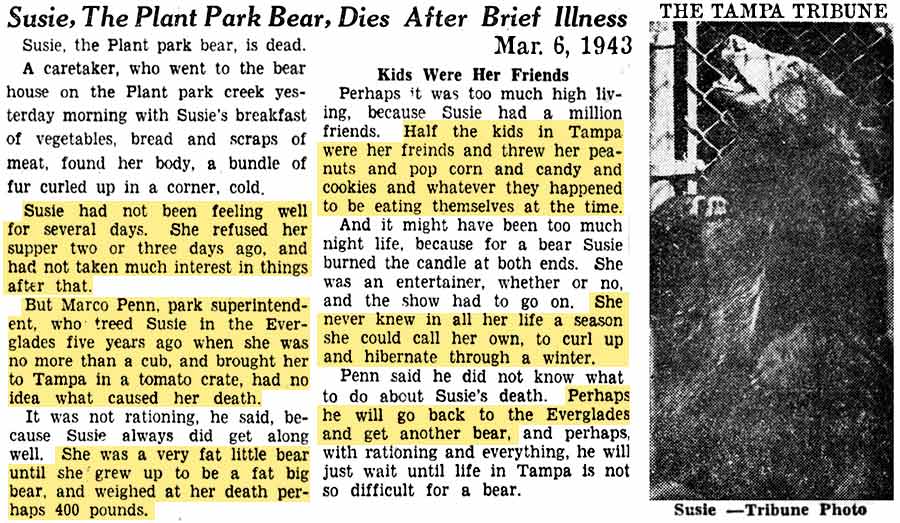
|
|
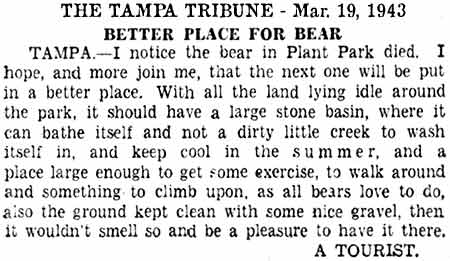 At right, a
tourist comments on the death of "the bear in Plant
Park" and hopes that the next bear will be given a
better habitat; one with a "large stone basin, where it
can bathe itself and keep cool in the summer," instead
of a "dirty little creek." Also, "a place large enough
to get some exercise" and something to climb upon, "as
all bears love to do." Also, the ground kept with clean
gravel so it wouldn't smell so bad and "be a pleasure to
have it there." At right, a
tourist comments on the death of "the bear in Plant
Park" and hopes that the next bear will be given a
better habitat; one with a "large stone basin, where it
can bathe itself and keep cool in the summer," instead
of a "dirty little creek." Also, "a place large enough
to get some exercise" and something to climb upon, "as
all bears love to do." Also, the ground kept with clean
gravel so it wouldn't smell so bad and "be a pleasure to
have it there."
The Mar. 28, 1943 article below "City Acquires New Bear
For Zoo.." also makes no mention of another bear. |
|
SO WHAT HAPPENED TO PAT?
There is no mention of another bear in the park in the
above Mar. 6, 1943 article. If Pat was still
around, you would expect a reference to him being
"without a friend," companion or partner, or, something
to the effect of being one bear left. |
 |
|
|
DATE OF ARTICLE |
Number of bears referred to or
implied by context |
|
1938 -
Feb. 12 |
Two
bears, photo of Pat being hand-fed a
peanut, and photo of Suzy. |
|
1938 -
Jun. 2 |
Two
bears, Letter from northern visitor
"...larger quarters for the
bears..." & "One old fellow..."
(Pat) |
|
1939 -
Jul. 29 |
Two
bears, "Bear Bites Hand..." -
Reference to "one of the bears" |
|
1939 -
Jul. 31 |
One
bear, "Tiger and Bear Wallow..." -
"The tiger and the bear..." |
|
1939 -
Nov. 6 |
One
bear, "Bear Bites Visitor" - "The
pet bear at Plant Park.." |
|
1940 -
Nov. 30 |
One
bear, "Plant Park Bear Nips Boy's
Finger" - "...was feeding the Plant
Park bear..." |
|
1942 -
May 24 |
One
bear, "A Traveling Reporter
Talks..." - "Plant Park and the bear
head the list." |
|
1942 -
May 24 photo |
One
bear, photo "You Can Still Feed The
Bear" and "The Plant Park bear
welcomes vacationists with
peanuts..." Encourages visitors to
hand feed them peanuts, (Same photo
of Pat used in the Feb.12, 1938
article.) |
|
1943 -
Mar. 5 |
One
bear, "Susie, The Plant Park Bear,
Dies..." - No reference to any
remaining bear. |
|
1943 -
Mar. 19 |
One
bear, Letter to Tribune from a
tourist: "Better place for
bear" - "I notice the bear in Plant
Park.." |
|
1943 -
Mar. 28 (below) |
One
bear, "City Acquires New Bear for
Zoo" - No mention of another bear to
get along with. |
It
is doubtful that something happened to Pat in the two
days from Jul. 29, 1939 to Jul. 31, 1939, because
something about him would likely have been said in the
Jul. 31 article. Since we can't know which of
those two article doesn't correctly reference the number
of bears, then Pat seems to have vanished between Jun.
2, 1938 and Nov. 6,
1939 without mention of what happened to him. The
newspapers may have been preoccupied with the events in
Europe; Hitler's atrocities and movements of troops in a
buildup to World War II. |
FEMALE CANADIAN
BEAR ADDED TO PLANT PARK
Just two weeks after Susie's death, a Canadian bear was
acquired by Marco Penn for Plant Park. She had no
name yet, "at least not a Tampa name, but that is
something you can attend to..." This implies
she had been given a name by the previous owners.
Future articles would identify her by different names,
possibly indicating she was never officially named, or if she was, it
wasn't well-known. There are articles calling her
Paddy, Bruin, and Susie--maybe because they didn't know
Susie died in 1943. Some refer to her as a "him."
The details on how old she was can be estimated.
Penn got her from C. W. Bray, who lives at Lake Carroll,
who had her "for the last year." He bought her
from a man in St. Pete who said she was "then about
eight months old and came from Canada." So the new
bear was probably about a year and eight months old, or
around 20 months old.
Later, a humorous article written by a reporter in the
form of an oral interview with this talking bear would give more
detail on how she was acquired. This article even
mentions that she was known by at least TWO names in
Tampa, and neither one was her name at her previous
home.
 |
|
This bear was a Canadian Black bear housed at a
wild animal zoo in St. Pete back in 1941.
When she was about eight months old,
Charles W. Bray, who lived at Lake Carroll, took
a trip there on Christmas day. The
bear was around 75 lbs. at
the time, and at the zoo she was known as
"Fatty." Bray bought Fatty as a
surprise Christmas gift for his wife, because
she always wanted a baby bear cub.
Bray took her home in his Crosley station wagon
and "all six feet" of Mr. Bray were in the
driver's seat and Fatty was in the back. Bray
had the windows shut so Fatty wouldn't escape,
and it was a hot day for a Canadian bear. On
Bray's trip back to his home at Lake Carroll,
Fatty would try to climb into the front seat but
Bray would toss food to the back for her--a bunch of
carrots, or a head of lettuce, which is what she
liked during her time in St. Pete.
Needless to say, when they arrived at home and
Mrs. Bray came out to see, she was indeed
surprised.
Fatty got along well with the Bray children, two
sons and a young daughter "Ardeth" (who by
Nov. 1955 was Mrs. E. E.
Webb.) Fatty and Ardeth spent a lot of
time together. They especially enjoyed climbing trees,
and with Fatty not even wearing
a collar or a chain leash.
Fatty shared the Bray family with their pet St.
Bernard, and Fatty took a liking to eating
raisins and drinking canned milk.
One day, Mrs. Bray held out her bottle to give
Fatty her milk and Fatty bit her hand and the
bottle, and ate the nipple right of it.
The Bray's grocery bill got higher and higher,
and Fatty seemed to like all the
foods that were hard to get during the WWII rationing
years. So after about a year, Fatty was off to "a nice home in Plant
Park."
At
Plant Park, Fatty's first friends were the pigeons, squirrels,
and the alligator in the pond.
Now and then, one of the Brays would visit. In
the next twelve years, Fatty would would be
called "Paddy," "Susie," and "Bruin" by
visitors and the press.
The
above information comes from an article
published on Nov. 19, 1955 which
attempted to show that
the Plant Park bear thinks it's better off being
in the zoo. Reporter "Panky Glamsch"
(surely a pen name) wrote in the form of an
interview with the bear, who happens to be a
talking bear, and freely shares her life events
and especially her opinions with the reporter.
The
article starts with the bear, at Plant Park,
speaking to the reporter "There I am, see,
minding my own business, when along comes this
dame and says, 'Oh, look at the poor bear--all
caged in." "I
look at her, roll over on my back, and almost
split the bars laughing to myself" Just
to keep the record straight, lady, I
say, you wanna hear a little story? The
bear proceeds to tell about events that led to
where she is now in 1955. From the rest of the
article we learn how she ended up at Plant Park.
|
|
PENN RECOVERS BODY OF DROWNING VICTIM
BELOW RIGHT: May 27, 1943 - Marco Penn recovered the
body of a man who had drowned in the Hillsborough
River just north of Sligh Avenue. Two men
drowned in the incident when their boat capsized.
A third man and a 4 year old boy survived the
incident. One body was recovered soon
afterwards, but the second man wasn't recovered
until the afternoon. This was the TENTH person
Penn had recovered in drownings. |
|
May 1, 1943 - Parks
Supt. Marco Penn gave a Plant Park gator to "Texas
Jim Mitchell," the owner of Sarasota reptile farm.
The gator had grown too big to keep at Plant Park.
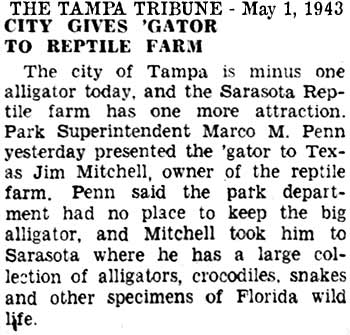 |
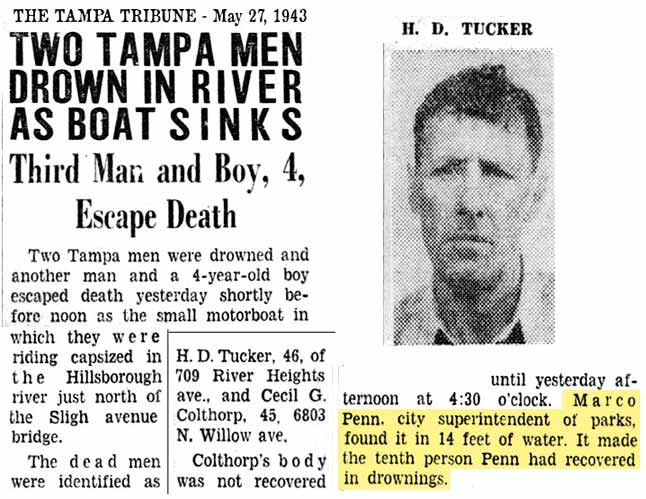 |
| |
THE MAYORAL ELECTION OF 1943, CHANCEY VS. HIXON
During the mayoral campaigns of Sept. 1943 between
incumbent Robert Chancey and Curtis Hixon, the Hixon
campaign launched attacks on the character of several
city administrators appointed by Chancey. On Sept.
20, 1943, Chancey defended each and every one of the
City appointees with a short paragraph on their
backgrounds in a large, full-page ad.
|
|
In his bid
for a fourth term in 1943, Mayor Chancey was opposed by
Hixon, a druggist who had come to Tampa from Alabama in
1910. Hixon had served two terms as city alderman, had
twice been elected as a county commissioner, and was
popular. He defeated Chancey by a large majority. The
election marked the beginning of a reform wave which
culminated in 1945 in a losing battle for the return of
the city manager form of government, but which effected
a charter revision providing for representatives elected
at large instead of by wards. It also increased the
powers and duties of the mayor.
With the election of Hixon in 1943, it was expected that
all of the current city department heads would be
terminated, including Marco Penn.


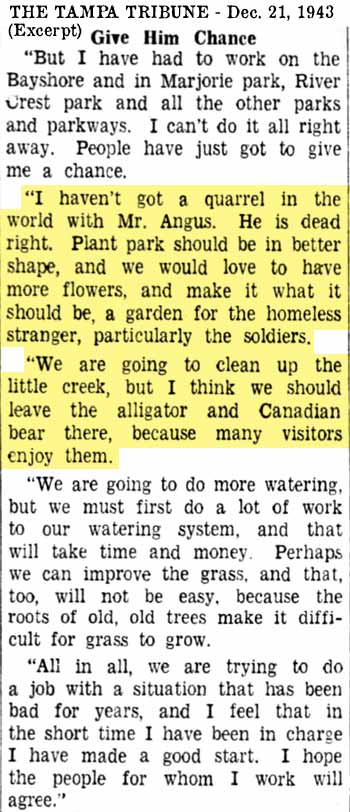 HIXON
APPOINTS BEN SANBORN AS PARKS SUPERINTENDENT HIXON
APPOINTS BEN SANBORN AS PARKS SUPERINTENDENT
Before
Hixon made his appointment to parks superintendent,
Marco Penn resigned. In Dec. 1943, Hixon appointed
Ben Sanborn, who had been working as the secretary of
the parks department for the past eight years under
Marco Penn. Soon after this, complaints arose
about the condition of Plant Park and Sanborn responded
in agreement, that the park was in bad shape. He
asked for patience, "I can't do it all right away" and
"we are trying to do a job with a situation that has
been bad for years..." He had been taking care of
work on Bayshore Blvd, Marjorie Park on Davis Islands,
and River Crest park, as well as others. He
planned to clean up the Plant Park creek, but wanted to
"leave the alligator and Canadian bear
there, because many visitors enjoy them." Plant
Park's zoo was down to two animals.
Penn went
back to devoting his time to his nursery business,
advertising daily in the newspaper classified sections. 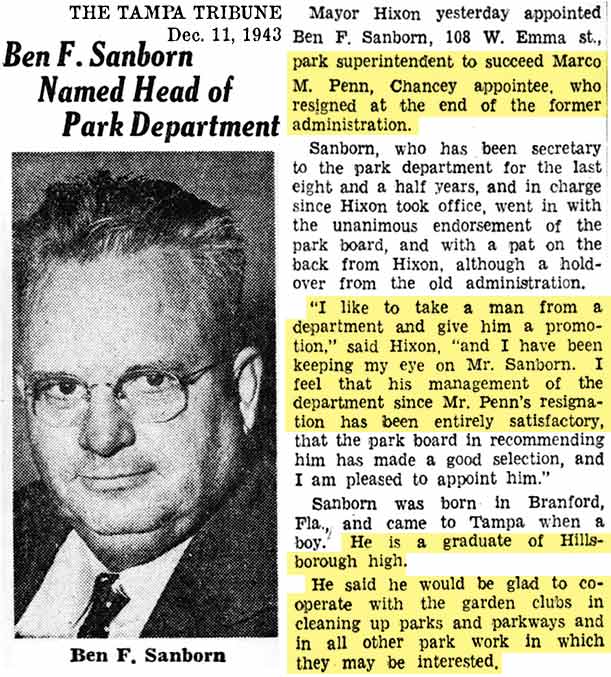
PENN ANNOUNCES CANDIDACY FOR COUNTY COMMISSION
In March
1944, Penn announced he would run against Fred Ball for
county commissioner in District 2. He promised to
work for a riverside drive from Sulphur Springs to
Bayshore Blvd, and advocated removal of tolls from the
Ben T. Davis Causeway bridge and the Gandy bridge.
He planned to set up a county nursery for his district,
like he did for the City, and beautify highways,
intersections, schools and churches by giving property
owners shrubs and trees to help landscape the district.
He also advocated a recreation program for the children
of his district. Penn was a nephew of the late
Judge Francis Robles, and had two grown daughters and
one young son by this time. He served in two major
battles of WWI and was a member of the Legionnaires.
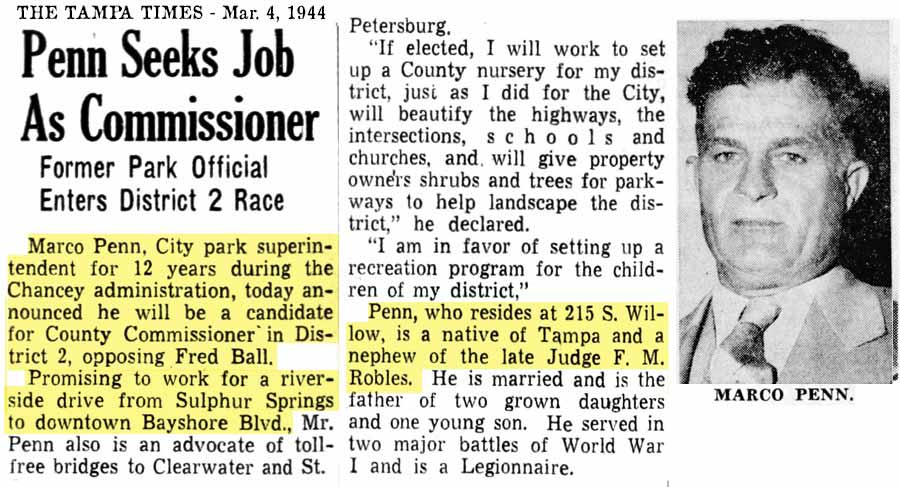
PENN FAILS TO QUALIFY
But as of Wed.,
March 15, Penn had not yet qualified to run, and
the deadline to do so was the next day.
When the clerk's office closed on Mar. 16,
Penn, and the candidate for sheriff, James Arp,
had not qualified.
|
|
|
|
PLANT PARK POPULAR WITH SOLDIERS, BUT FOR THE WRONG
REASON
Mayor Hixon
took office at the peak of the war, when the city was
filled with servicemen, and he put the resources of the
city into drives to curb vice and venereal diseases,
which had taken an upturn during the war years. He also
began building up city departments which had become run
down during the long depression years. He was able to
perform this much-needed task because the city had by
that time started to become prosperous again and tax
payments were increasing steadily.
By May
1944, Plant Park had become an illicit rendezvous place
for soldiers and girls. The result of a survey
showed that 14 percent of the cases of venereal diseases
were contracted in Plant Park, with hotels leading the
group at 51 percent. It was described as a
difficult matter because Tampa police could not make an
arrest without the right kind of evidence, and although
servicemen were subject to civilian law, "they are
turned over to the military and what the military does
to them is military business." Sanborn said the
night watchman is on duty from 5:30 p.m. to midnight,
"and it is impossible for him to chaperon all the
neckers in Plant Park."
He went on
to say, "Nobody knows the troubles we have. They,
soldiers and civilians, break up our park benches and
even use them to make fires. They throw the wood
and metal benches in the river and upset the concrete
ones which weigh 900 pounds. They've about torn down the
animal cages and even break pieces of cement off the
Lafayette St. bridge to throw at our poor alligator."
Sanborn felt this matter was a least partly the
responsibility of the military. The fact that the
MacDill ferry landing was at the Plant Park dock made
the park more of a meeting place than it otherwise would
have been.
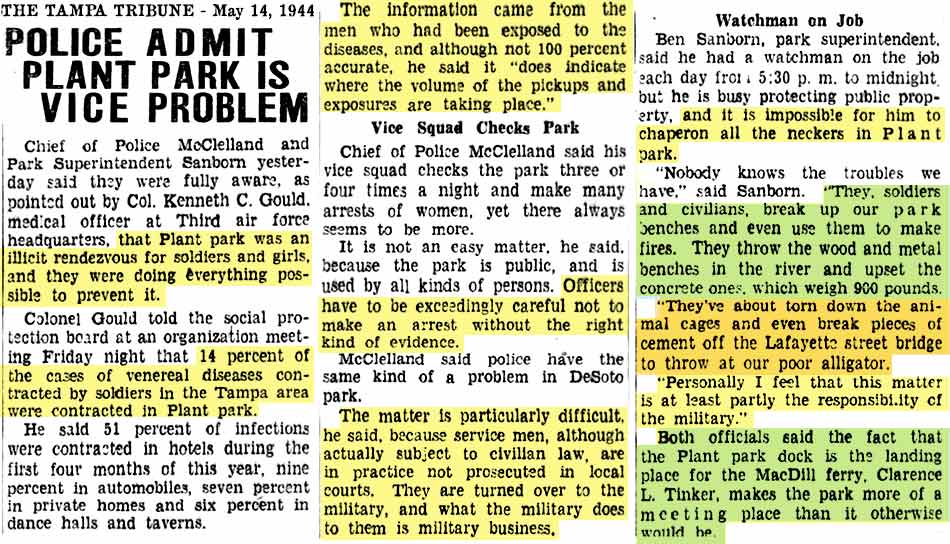
|
CANADIAN BLACK BEAR IS "PADDY"?
The July 8, 1945 article
claims the bear is "Paddy" and he is a
vegetarian. He lives on a summer diet of lettuce,
oranges and scraps, and ignores any meat mixed in
his daily eight-quart bucket of food. Maybe
"Paddy" was somehow a mistaken version of her original
name "Fatty" from her zoo days in St. Pete. |
HEAVY RAIN SWAMPS PARKS
July 27,
1945- Heavy rains made low portions of Plant Park and
Lowry park swampy, but the TWO remaining animals at
Plant park, an alligator and a Canadian bear,
survived without harm. |
"BRUIN"
IS OUT OF DANGER
July 31, 1945 The Times covers the
same heavy rains incident and calls
the bear "Bruin" and that
he was in danger when the water
level of the stream running through
his cage began to rise quickly, but
the rain slowed to a trickle and "Bruin"
was safe. |
|
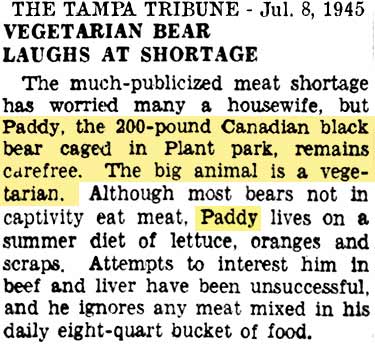 |
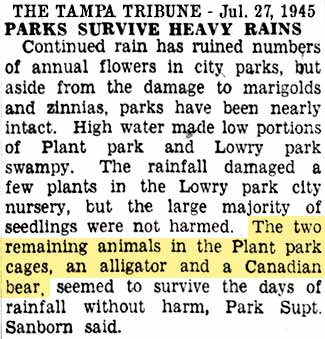 |
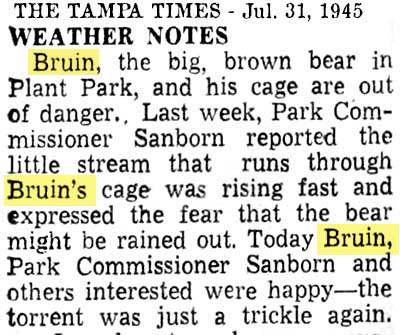 |
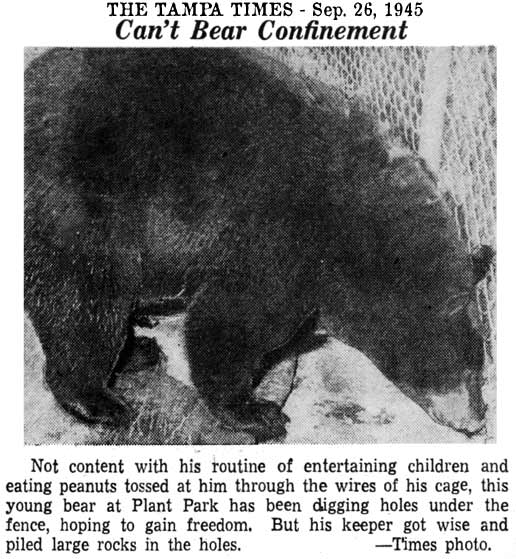
Fatty has been
trying to dig out of her cage by going under the
fence but rocks were placed in the holes to
prevent her escape.
ANIMAL ABUSE ADDRESSED
In
an attempt to stop the abuse of "Gator" by
visitors, a couple of instances were addressed
in court, one resulting in a fine for the
abuser. Sanborn claims they don't mean to
harm Gator, they only want to see him move
because he lays around like a log in the sun too
much. Sanborn said one time he saw
"reckless young soldiers" throw a park bench at
Gator's head, but missed him. Sanborn got
the Humane Society involved and they too were
furious about the abuse. The "crackdown"
on the sadists, "the kind of guys who go around
zoos trying to set fire to monkeys' tails,
resulted in molesters being severely lectured
and warned. It had become an epidemic of
abuse.
The
article claims "Gator" (the only name he has)
has been there some 16 years and was brought to
Plant Park with four other gators by Tampans who
rounded them up from outlying ponds. Gator
was 11 feet long, but his companions "succumbed
to captivity as the years went by.
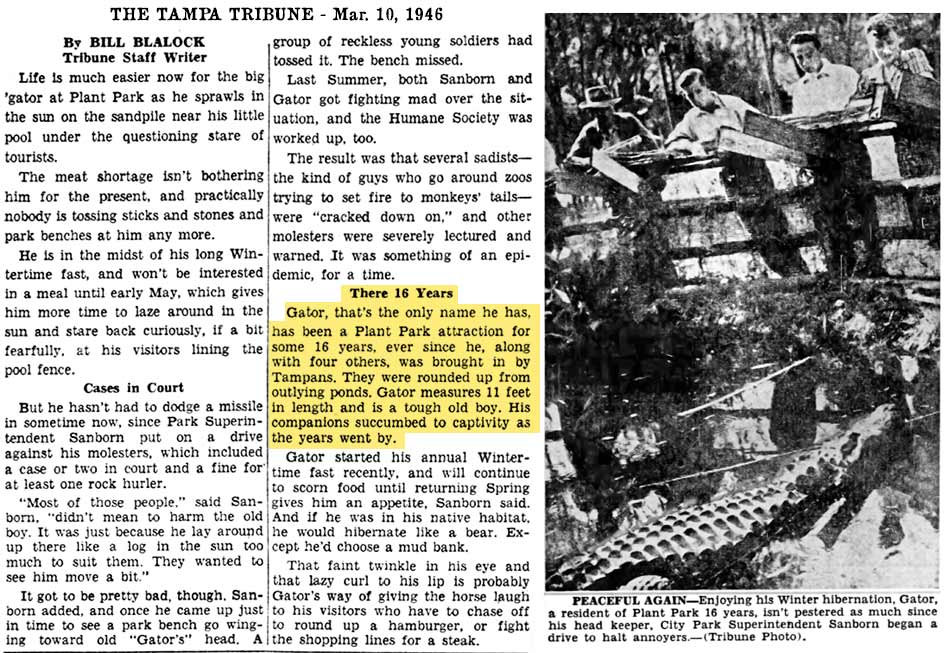
|
THANKS, BUT NO THANKS--GATOR TURNED
DOWN BY ZOO
What
to do with a 4.5-ft. long gator
captured on a crabbing expedition in
Hillsborough Bay is described as a
"problem" when it was turned down by
Parks Dept. Supt. Sanborn, and then
by Prof. Clyde Reed, head of the
University Of Tampa's biology
department, who couldn't use the
gator because they would have to get
a special permit from the Florida
Game and Fresh Water Fish
Commission, and March through May
are "closed seasons on alligators."
Sanborn feared the gator would be
eaten by the the large gator.
Perhaps returning the gator to the
wild would have been the simplest
solution.
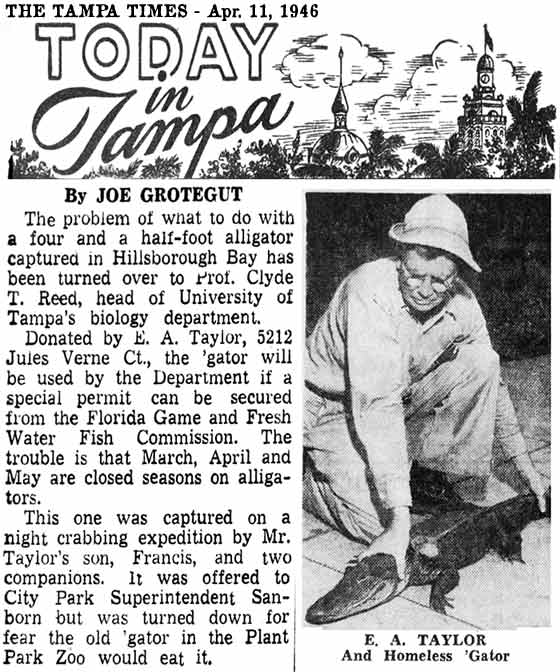 |
CLERGYMAN CHARGED WITH GATOR ABUSE
Rev. J. L. Whitaker was witnessed by
Parks Supt. Sanborn breaking off a
bamboo stick in Plant Park and using
it to poke at the gator.
Sanborn arrested him and was
convicted in municipal court where
he was ordered to pay $50 in fines
or serve 50 days in jail.
Albert Boyd, (former?) owner of
Boyd's service station zoo, was
president of the Humane Society and
testified "to speak for dumb
creatures who aren't able to speak
for themselves."
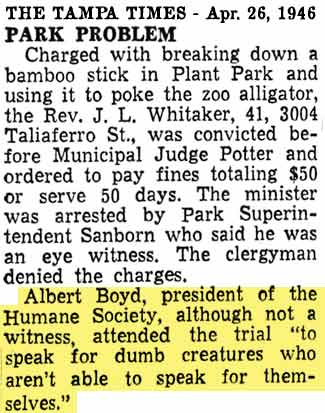
|
|
|
ZOO GETS A RHESUS MONKEY
In late September, 1946, a rhesus monkey
named "Cracker" was donated to the zoo by
Mrs. L. B. Barnard. She had raised the
monkey "from a pup," bottle feeding him,
when his mother died in a monkey circus up
north. But now Cracker was a
"strapping big fellow, and well able to fend
for himself. So don't put your hand in
the cage, kids."
A brand new cage was built for Cracker by
Sanborn, near the bear pen, where Cracker
was getting lots of attention for his
"unique jaw pouches, into which he crams
food for safe-keeping until he is ready to
consume it."
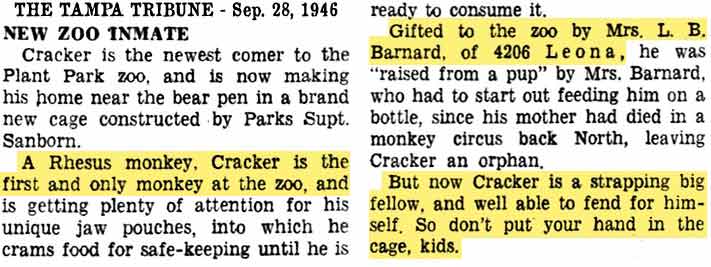
|
|
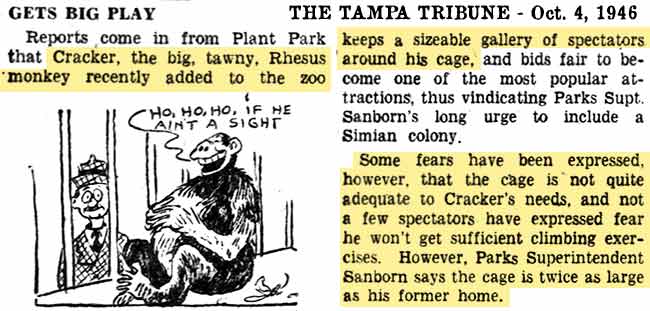
CRACKER IS A HIT
The "big, tawny, Rhesus monkey" is bringing
in the crowds, answering Sanborn's wish to
start a "Simian colony."
But some visitors have expressed concern
that his cage is too small and he won't get
sufficient climbing exercise.
Sanborn's response: It's twice as big
as his former home.
(Well that certainly solves the problem.)
|
THIS IS WHY WE CAN NEVER HAVE
NICE THINGS; CRACKER MOVED TO
AVOID ABUSE
After only 3 weeks, Cracker had
to be moved from Plant Park to
"the comparative quietude of
Lowry Park" so as to be "free
from the annoyances of curious,
careless zoo visitors."
The Tribune describes abuse with
terms such as "overzealous
antics of persons anxious to see
him perform tricks and who were
not above punching sticks into
his cage to give him
encouragement." And, "mild
little mannerisms" such as
"giving the wire of his cage a
resounding whack to startle him
out of a thoughtful doze."
The article says you could see
the puzzlement in his eyes,
wondering why he was the one in
the cage and not the spectators.
"Had folks fed him a banana
instead of a stick, great would
have been the reward for more of
them." Some visitors were
understanding, those who enjoyed
watching him and spoke to him
soothingly and softly would see
Cracker "blossemed out for them,
a friendly cuss in return, and
they miss him."
|
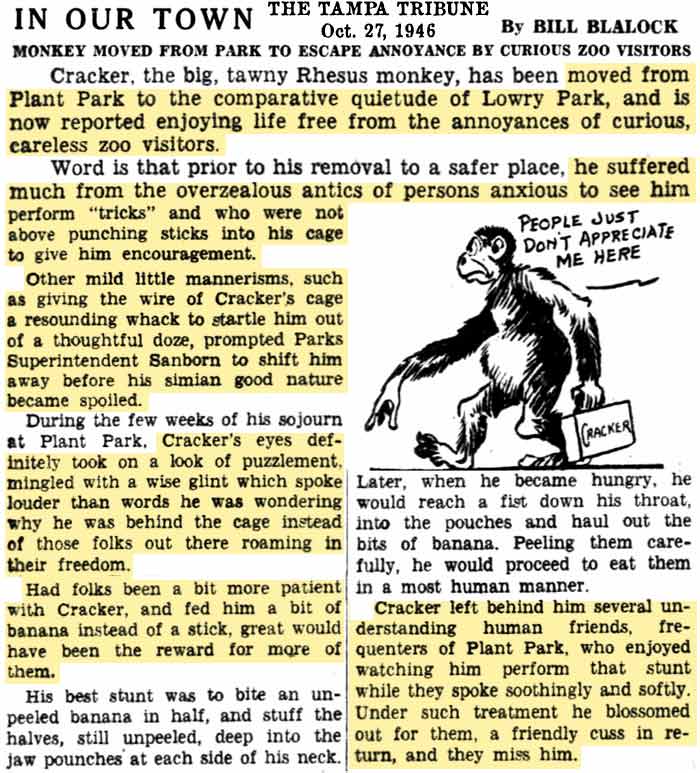 |
RATS GET BOLDER
Rats at Plant Park continue to
be a problem as visitors
recently complained, the now
were making daylight raids to
snatch the bear's food, sneaking
in from nests in the shrubbery.
Park attendants began to remove
all uneaten food from the bear
cage overnight as a means of
curbing the rats rule.
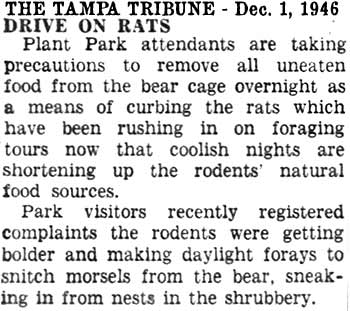 |
|
Tribune artist seems to think a
rhesus monkey looks like a
chimpanzee, which is an ape and
has no tail. |
| |
|
CRACKER GETS LONELY
By mid-December, 1946,
Cracker was showing signs of
loneliness at his secluded
Lowry Park cage. When
infrequent visitors appear,
"he jumps and mutters in
ecstasy." |
PUBLIC OPINION IS TO LET THE
BEAR AND ALLIGATOR RETIRE
It is said that the bear
seems to shun crowds, and
spends most of his time in
the obscurity of his den,
with only his nose tip
visible. The "lazy old
gator refuses to lash his
tail, bark, or otherwise put
up a show, being content to
remain submerged like a
log." So now only the
birds and squirrels
entertain, all free of cost
to the taxpayers.
Visitors say retire them and
save the city the cost of
housing and feeding them,
before "Father Time" retires
them more permanently.
It looks more and more like
zoo patrons are out to see
animals perform tricks for
them, to entertain them with
some sort of act that may or
may not be natural to their
behavior. What they
want, in effect, is a
circus. |
 |
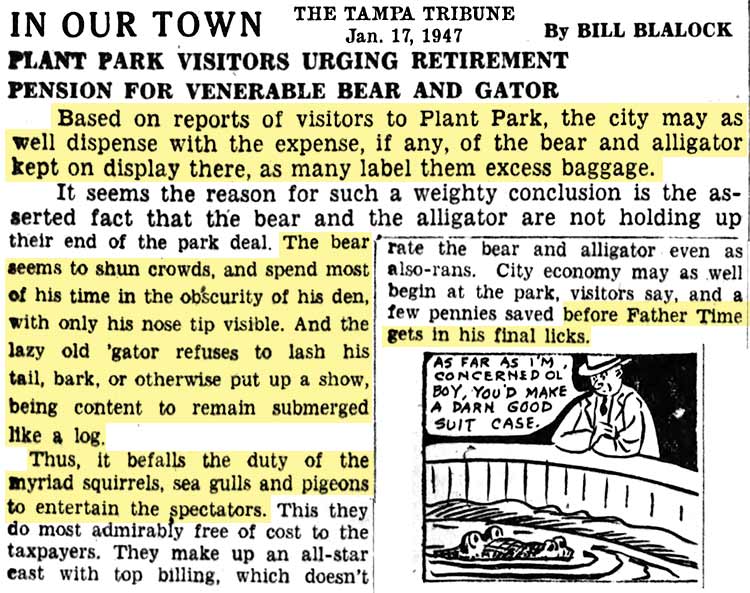 |
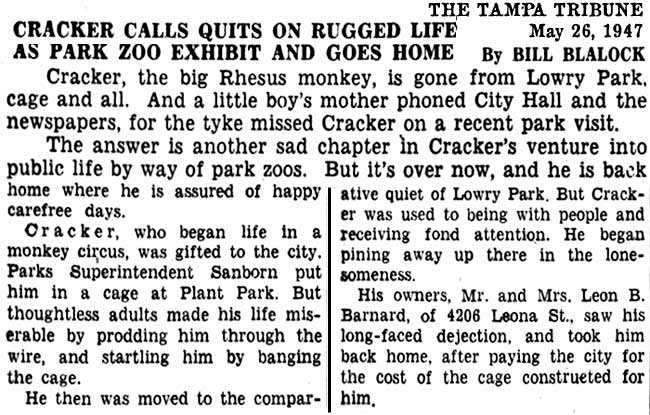
CRACKER GOES BACK HOME
As the Tribune put it in late May, 1947,
"Another sad chapter in Cracker's
venture into public life" has been
written and ended.
He was moved to Lowry Park from Plant
Park because of "thoughtless adults who
made his life miserable by prodding him
through the wire of his cage, and
startling him by banging the cage."
But he was used to being with people
(nice people) and receiving fond
attention. His owners saw his
"long-faced" dejection and took him back
home, after reimbursing the City for the
cost of the cage that was built for him.
Heavy
rains caused flooding all over Tampa in
late Sept. 1947, especially along
Bayshore Blvd. and in the south Tampa
area around Watrous Ave, where two other
photos were taken. Here, the
Tribune says the "caged bear in Plant
Park" seems unconcerned and sits out the
flood, despite the fact that seems to be
up to its neck in the water.
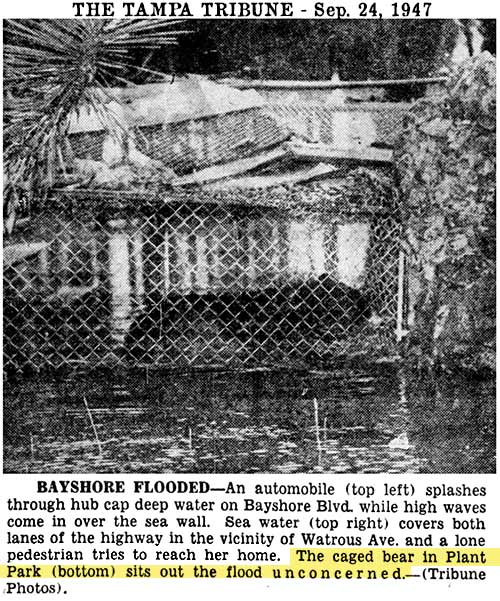
CHILD
BITTEN (OR CLAWED) BY PLANT PARK BEAR
A three year-old child was bitten
(according to the Tribune) but the Times
says "Bear Claws Child" then states "bitten
or clawed." she ventured too close to
the bear cage and received minor cuts on her
right hand. She was viewing the bear
with her mother when the incident occurred.
(Injury to her hand would seem to indicate
she was attempting to feed or pet the bear.)
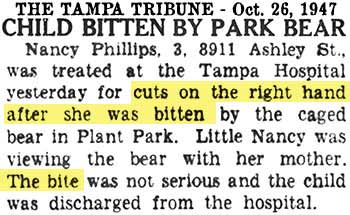
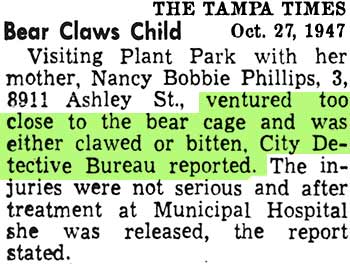
PIGEON KILLER HAS NO EXPLANATION FOR JUDGE
ABOUT HIS BEHAVIOR
A 71-year-old tourist from Pennsylvania was
seen in Plant Park luring pigeons with feed
then killing them with a stick and putting
them in a sack. He was convicted in
municipal court and given a choice of $50
fine or 25 days in the city stockade.
The man pled guilty, but had no explanation
for his conduct when questioned by the
judge.
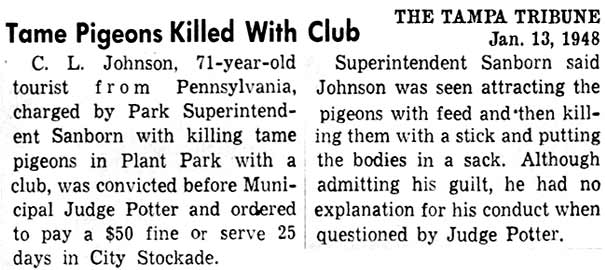
TAMPA WANTS TO
BE HOME OF THE 1949 CONVENTION
The Chamber of Commerce Convention Bureau
and the Tampa Parks Board wants to lure the
American Institute of Park Executives into
holding their 1949 convention in Tampa, but
the organization is comprised of park
executives, recreation supervixors, AND
zookeepers, and they point out that a city
must not only have parks and recreational
facilities to visit and inspect, but also a
well stocked zoo. The article mentions
the "lone alligator pen" in Plant Park and
overlooks the bear cage. So it's
really a "TWO-CAGE Zoo." There is hope
that Jacksonville is awarded the convention
because their plan was to spread the
convention over several principal Florida
cities.
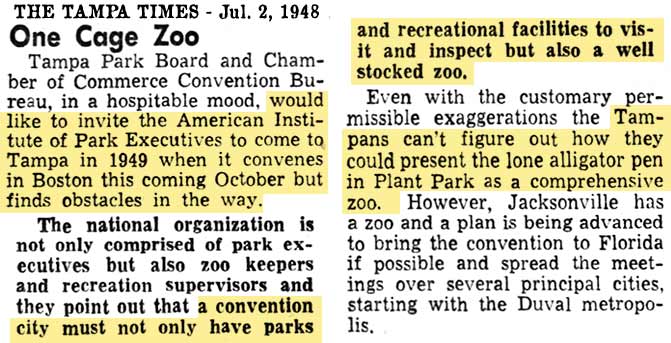
FORMATION OF THE HILLSBOROUGH COUNTY ZOO
ASSOCIATION
Paul Wilder, columnist for the Tribune's "IN
OUR TOWN" announced formation of a mock zoo
association with himself as the "Keeper pro
tem" and solicited suggestions and plans for
making Tampa known as "the best home for
wild animals in the world." He says "what
this town needs is a darn good zoo" and
lists the current zoo denizens: a lot of
squirrels, a lot of pigeons, a bear, and an
alligator. He suggests a good zoo
would bring in visitors from miles around.
Father's would bring their kids to the zoo
while mom shopped at nearby downtown stores,
and thus recapture some of the business lost
to Orlando, St. Pete, and other shopping
centers. He presents the reality;
having a good zoo takes money. Cages
cost money, animals need to be fed and
protected from the public with somebody on
duty. He reveals that once, B. F.
Sanborn caught a man beating the tiger in
the face with his cane.
Apparently, the City has decided that with
increased expenses, a city-financed zoo was
not possible at this time and would mean
just "one more headache." He
says this "pillar of wisdom reflects that a
zoo must be promoted by a private
organization.
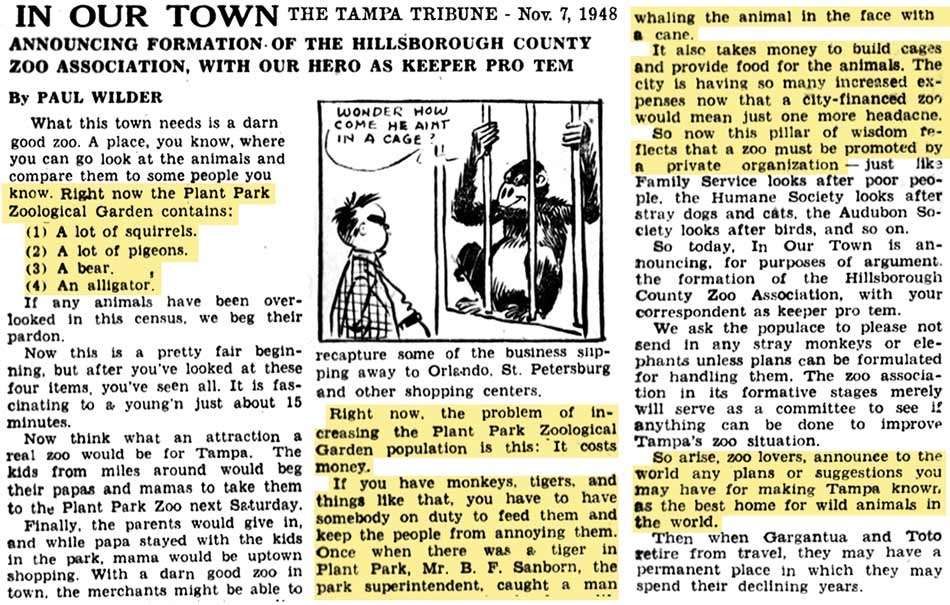
|
TOURIST DESCRIBES A RUN-DOWN
SUB-PAR ZOO
Whether or not this was a
response to Mr. Wilder's
solicitation for ideas is not
known, but this tourist was
extremely disappointed with the
"small zoo" described in the
tourist brochure. The
writer suggests it would take
little to improve the place,
including a better fence around
the "very small alligator pool"
so that small boys "could not
poke at its eyes, as on
yesterday." |
WILDER'S "ZOO ASSOCIATION" A
DISMAL FAILURE
Although no such announcement
could be found, Wilder claims he
appointed "Big John" Riegel as
president of the "In Our Town
Zoo Association" which was
dedicated to getting more than a
bear and an alligator in Plant
Park. It was a dismal
failure, as it appears only the
letter at left was submitted.
This article goes on to describe
some sort of congressional
campaign he was launching. |
|
 |
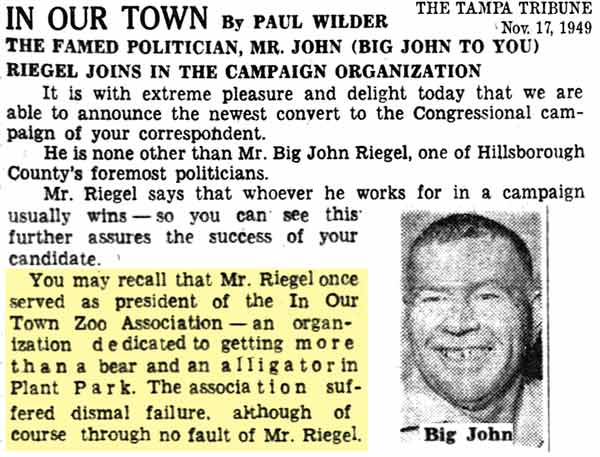 |
|
THE PIED PIPER OF PLANT PARK
This edition of "In Our Town" by
Paul Wilder describes
80-year-old Mr. E. P.
Duffy, the "Pied Piper of Plant
Park." Almost every day
for 15 years he could be found
feeding the squirrels, which he
had given each one a name and
could recognize them.
"Down
trees, across lawns, the
squirrels come running.
Like a benign St. Patrick
followed by thousands of rats*
Mr. Duffy proceeds along,
scattering pecans..."
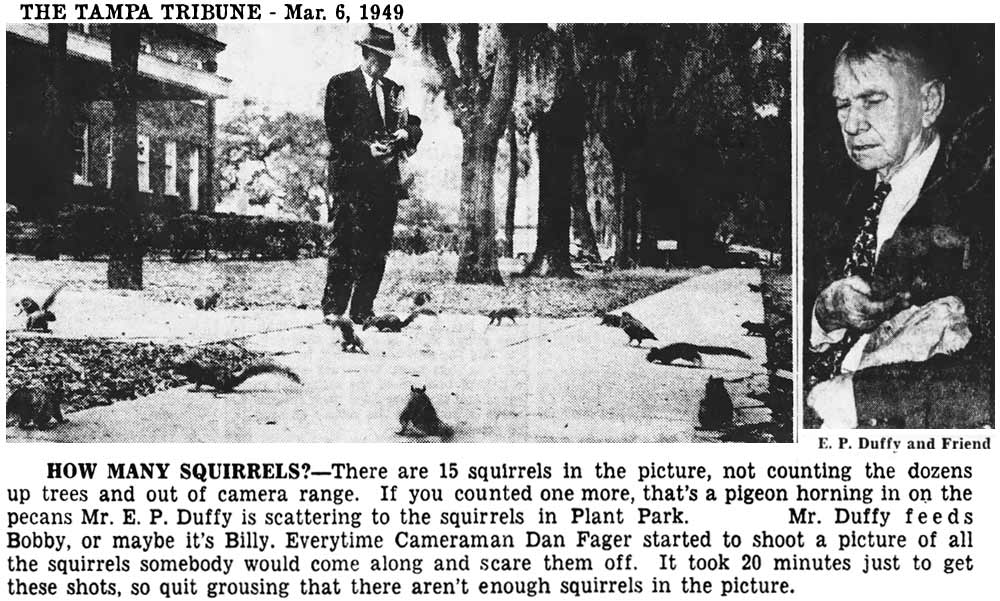 |
TAMPA TRANSIT LINES AD
Mother, take your children to
see the animals! (All two
of them.) |
|
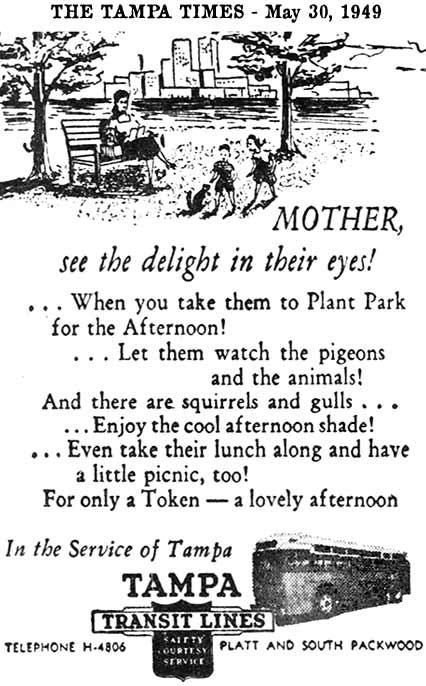 |
|
*Mr. Wilder
has confused St. Patrick with
the Pied Piper. St.
Patrick is credited with ridding
Ireland of all its snakes.
Supposedly, there are no
indigenous snakes in Ireland. |
|
READ THE ACCOMPANYING ARTICLE: "IN OUR TOWN: The Pied Piper of Plant
Park" |
|
SNOUT OR
CLAW, TAMPA YOUNGSTER IS LOADED FOR BEAR
Oct. 7, 1949
A Tampa
mother, Mrs. Joseph Longo, claimed her 20 month-old son
Johnny was bitten by Susie, the "300-pound Plant Park
bear." (This was the THIRD bear at Plant Park,
acquired shortly after the "original" Susie died.)
She says they stopped briefly in front of the bear cage
and Susie stuck out her snout through an opening between
the cage and the gate and clamped down on the
youngster's "sitter" (rear end.) She also said
that she "clawed the bruin frantically to free the
child," clawing the bear's face with her fingernails to
force Susie to release her hold on Johnny.
But City
Park's Superintendent Sanborn said "Why that bear is
harmless," and in his opinion it was impossible
for Susie to have made the bite through the three and
one-quarter inch opening in the cage. An
eye-witness story had a different version. James
Sofianos, who sells peanuts from a wagon near the cage,
said "the mother allowed her son to get too near the
cage opening and Susie reached a paw through and struck
the youngster."
Sanborn
said there was metal screen to protect children from
such mishaps, but that visitors had pulled it away from
the opening which Susie reportedly used in injuring the
child. He added that a metal plate would be welded
over the opening to prevent this from happening again. |
|
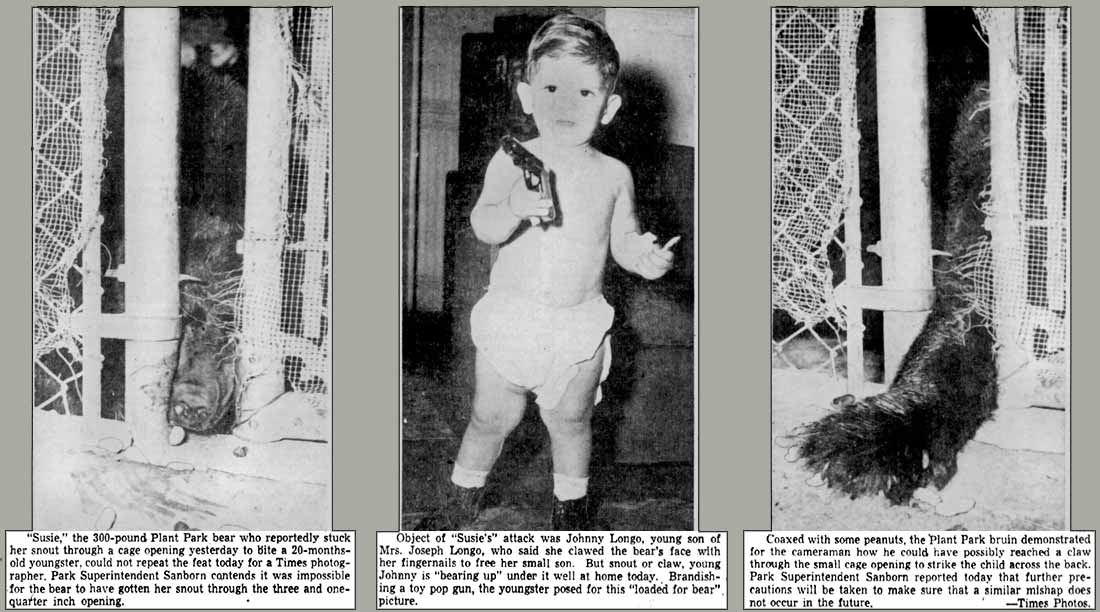
The
reporter refers to Susie in the first photo as "her" and
in the last photo as "he."
READ the
entire Oct. 7, 1949 Tampa Times article. |
| |
|
THE TAMPA
TRIBUNE HAD MORE TO SAY, AND SHOW
The
Tribune story carried more details and featured a photo
showing the gap in the wire mesh up higher along the
gate, where the padlock was located. It appears that the
gap here was wider, even though the bear isn't sticking
it's snout through it. When Mrs. Longo heard
Johnny screaming, he "was caught in the bear's jaws
through an opening between the cage and the gate."
She jabbed her sharp fingernails into the bear's
nostrils for it to turn Johnny loose. She saw a
"terrible torn place" where the bear had bitten and she
rushed him across Lafayette St. to the Park theater,
hold the wound tightly. There, she found a doctor
who called the hospital and another doctor to arrange
immediate surgery. A kind gentleman whose name she
did not get drove them to the hospital.
The
attending physician said the bite was "pretty severe"
with the boy's right buttock sustaining a three-inch
long, inch-and-a-half deep gash. The bite just
missed his rectum by a fraction of an inch, otherwise
the gash could have been serious or even critical.
It took eight stitches to close the wound. Once
home, the boy continued to be traumatized and refused to
go to bed. When the reporter got there, they were
still holding him trying to console him.
The attending physician
told the reporter that he had "sewn up" a child several
months ago, and afterward notified the City Board of
Representatives suggesting that they do something about
that bear.
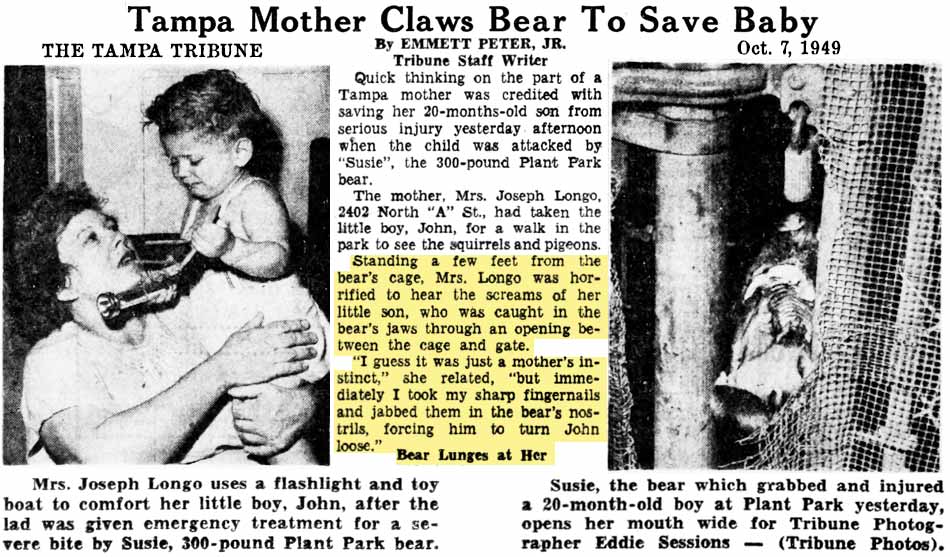
B. F. Sanborn, Parks Dept.
Supt., said he hadn't been "officially notified" that a
child had been attacked. It's not clear if this
was in response to this incident or the one several
months ago. "It's hard to believe" said
Sanborn, "That bear is such a PET." He claimed
that he repeatedly had put fine mesh wire across the
opening, but that the public pushed it aside or tore it
down so they could feed peanuts to the bear.
Johnny's father felt the City was negligent and planned
to ask the BoR to pay Johnny's medical and hospital
bills.
Mayor
Hixon said the City would be glad to take care of the
bills, and would take immediate precautions to see that
the public is properly safeguarded from the bear.
He said, "We'll take care of it, even if we have to get
rid of the bear. I didnt know the bear was
vicious, if I had received any such word, I can assure
you the attack wouldn't have happened this afternoon."
READ THE REST OF THE ARTICLE
"SUSIE"
GIVEN ONE MORE CHANCE, MAYOR TELLS SANBORN TO "FIND A
SAFEGUARD."
Mayor Hixon:
"If an effective safeguard is not found, the city will
get rid of the bear." After the publicity of the
Longo incident, Max Star called the Tribune to say his
little grandson was scratched by Susie's claw through
the opening two weeks earlier. The tot was
feeding Susie peanuts through the opening when the bear
reached through and clawed his hand.
It should
be pretty obvious by now that visitors to the park who
fed or allowed their children to feed the bear thought
they should be able to feed a wild bear by hand if it's
in a cage and not have it bite or gash you with its
claw, as if being confined to a cage for years somehow
domesticates them.
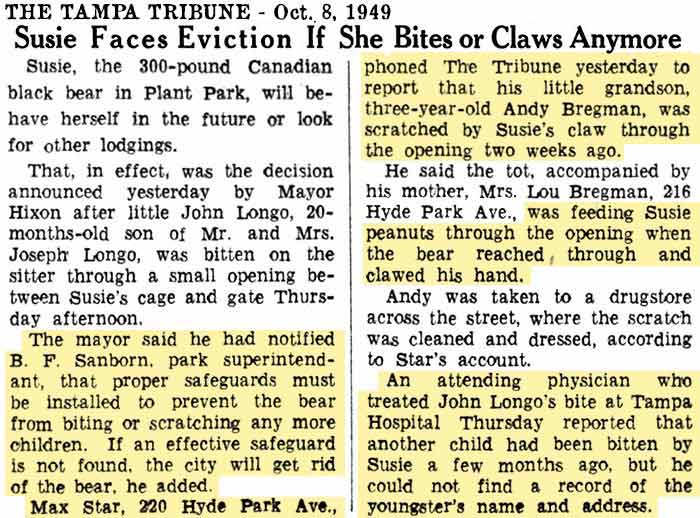
TRIBUNE
READERS DEFEND SUSIE
C. R.
ELFERS wrote the Tribune in defense of Susie, saying he
frequently saw children molest the bear, many times more
than she had molested children. Children
would delight in poking Susie with sticks if she was
napping near the cage fence, as well as throw dirt into
her face. "In fact, they will do everything
possible to disturb her." All this, while the
parents "stand by watching and will laugh. To
them, the acts of their children are funny." When
Susie can't stand it anymore, she gets up and walks
away. Elfers also said she needs a larger and more
respectable home. "The dilapidated and
unsightly one she now occupies is a DISGRACE to
beautiful Plant Park." Elfers had the
solution; "Build a new one, put a rail around it
five feet from the cage, and have a heavy mesh fence
attached to it so children can't crawl under it.
Susie will no longer be molested and incidents like the
one just reported will stop."
.jpg)
|
Mrs. Edward
Lowery agreed with Elfers. She
has seen children torment the bear while
parents stand by doing nothing. She
suggests arresting anyone caught molesting
her, and to build her a proper cage.
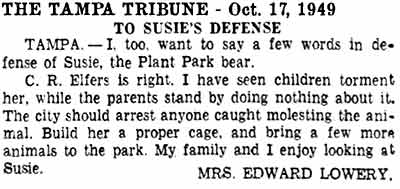
|
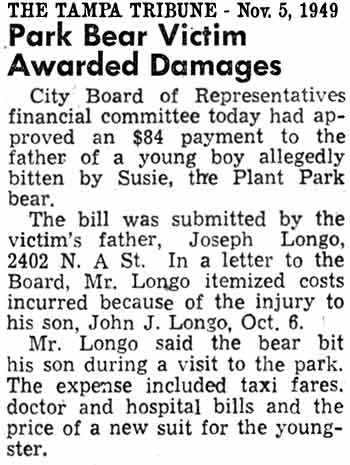 |
|
AT RIGHT: The Board of
Representatives approved a payment to the
Longo family of $84. The itemized
costs included taxi fares, doctor and
hospital bills, and the price of a new suit
for Johnny. (To replace a shredded one
he was wearing at the time of the "alleged"
attack?) The amount may not seem like
much today, but in 1949 it was what $935
would be to us today.
U.S. Inflation Calculator |
|
PARKS DEPT. OFFICE MOVES TO LOWRY PARK.
In
late July, 1952, Parks Supt. Ben Sanborn
announced that he had moved the parks
dept. office from the building at the
entrance to Plant Park to a new location
at Lowry Park. The new location
provided more room and the location more
suitable.
|
ANOTHER BEAR BITE CLAIM
Mayor Hixon must have forgotten about
his "one more time and the bear goes"
rule for the Plant Park bear.
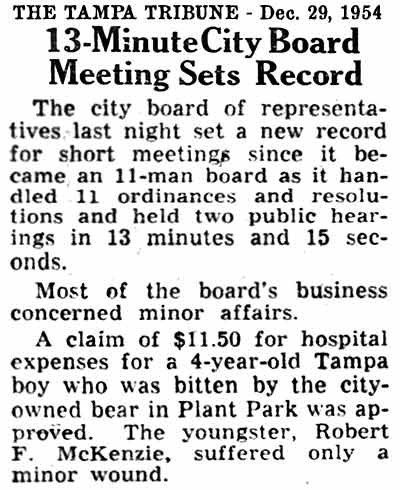 |
|
 |
|
A TALKING BEAR AT PLANT PARK ZOO
(The subject of this article was used earlier on
this page when the bear was acquired.)

An article
published on Nov. 19, 1955 attempts to show that
the Plant Park bear thinks it's better off being
in the zoo. Reporter "Panky Glamsch"
(surely a pen name) wrote in the form of an
interview with the bear, who happens to be a
talking bear, and freely shares her life events
and especially her opinions with the reporter.
Text in italics is the bear quoting herself from
previous events in her life.
The
article starts with the bear, at Plant Park,
speaking to the reporter "There I am, see,
minding my own business, when along comes this
dame and says, 'Oh, look at the poor bear--all
caged in."
"I
look at her, roll over on my back, and almost
split the bars laughing to myself" Just
to keep the record straight, lady, I
say, you wanna hear a little story?
The
bear proceeds to tell about events that led to
where she is now. From the rest of the
article we learn how she ended up at Plant Park.
Read the whole article: Sister Bear Decides Life
in a Zoo Has Advantages, Nov. 19, 1955 |
|
BOARD OF CITY
COMMISSIONERS GOES BANANAS
Nothing much seems to have been accomplished on the
the last weekday of 1955, as it appears this meeting
of the City Commissioners was more joking and and
monkey-business than accomplishing anything serious.
Likewise, the Tribune's article (and the Times' much
shorter article) seemed to be for entertainment,
rather than news--the purpose of which was to show
how punny the city commissioners could be.
If
anything can be believed here, it would be the
highlighted portions...
Of
significance is that the chairman of the board of
city commissioners was Junie L. Young, Jr. Within
six months from this meeting, he would be thrust
into the mayor's seat as Mayor Pro Tem upon the
death of Mayor Curtis Hixon in May 1956.
But after this article, no mention is found again in
the newspapers about the Plant Park zoo or its only
two animals, who by this time are an approximately
25-year-old gator and a nearly 14-year-old Canadian
black bear.
|
|
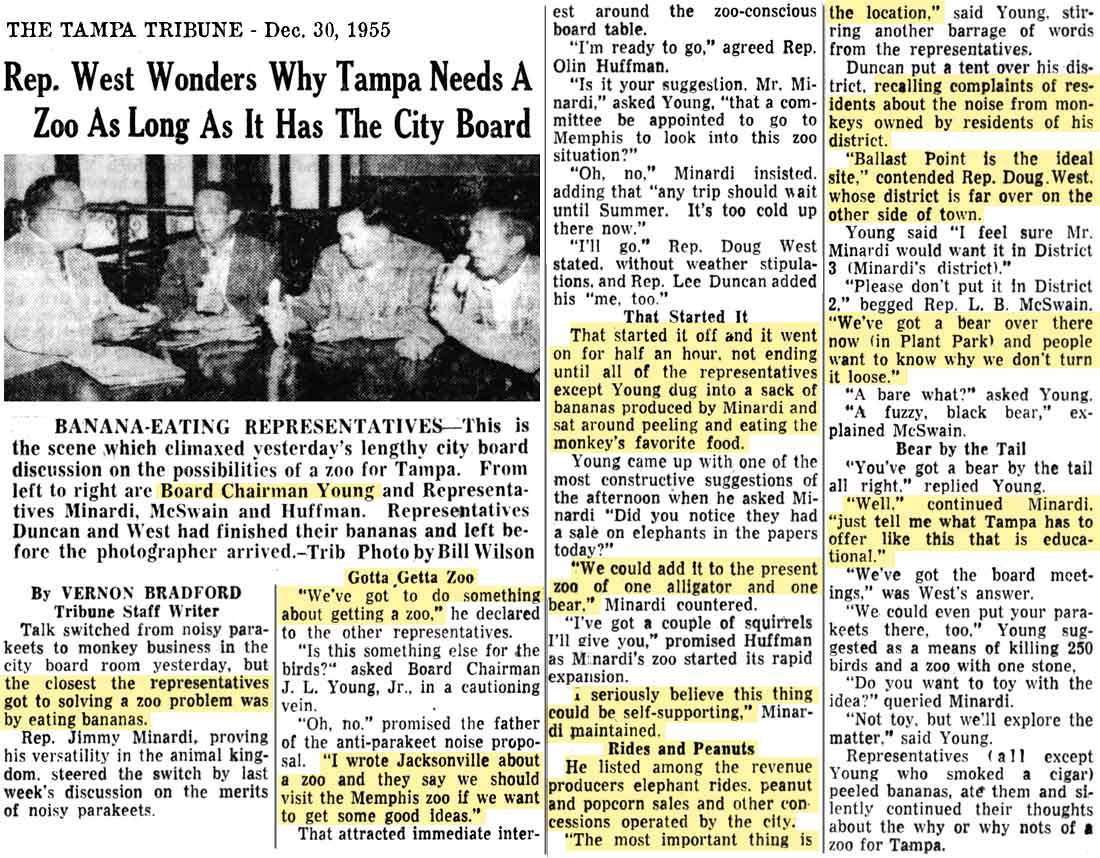 |
NICK NUCCIO ELECTED
MAYOR BY THE HAIR OF HIS CHINNY-CHIN CHIN
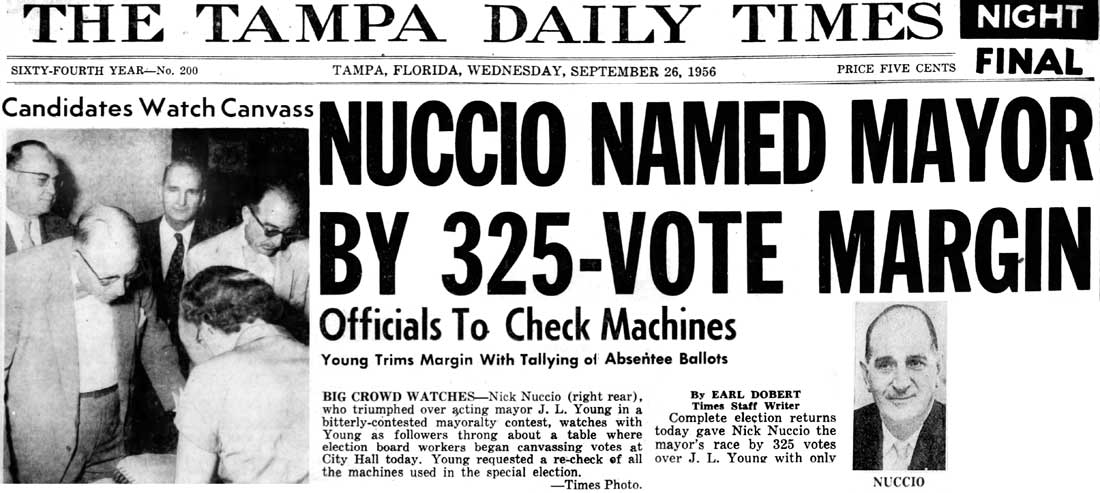
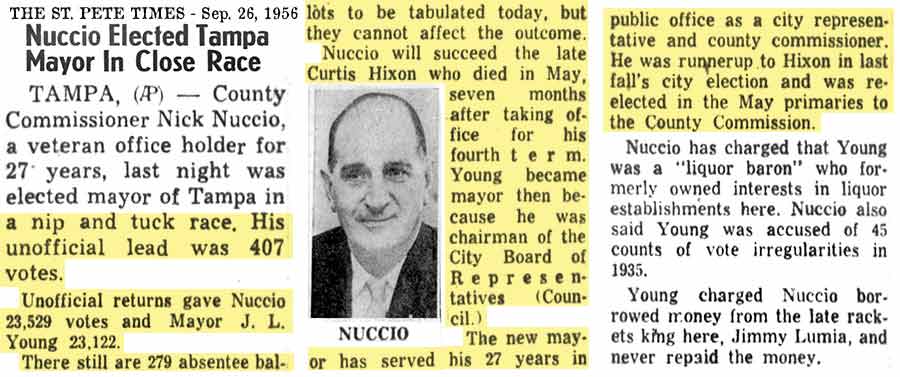
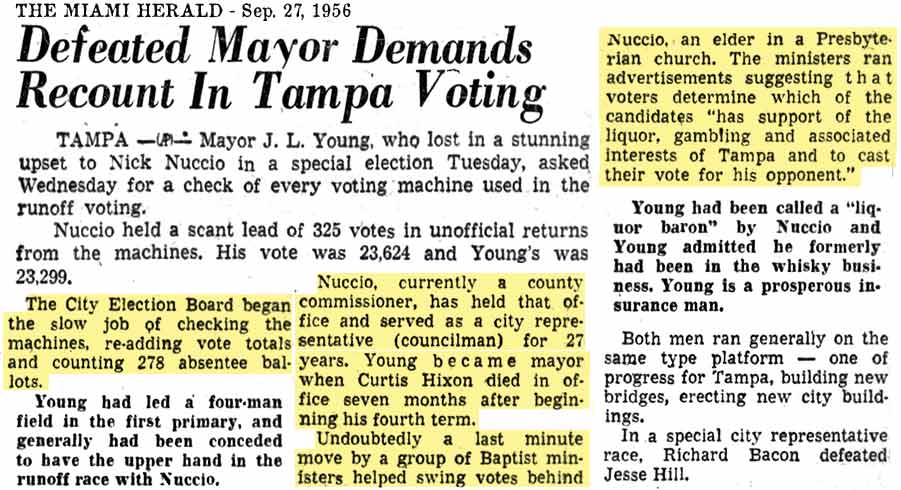
| |
|
|
Nuccio's margin was reduced to 125 votes after the
recount. $15,000 annual salary may not seem like
much, but in 1956 it was like $146,071 is to us today
according to
U.S. Inflation Calculator.
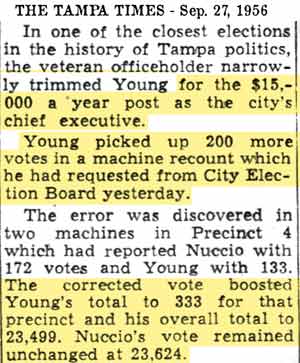 |
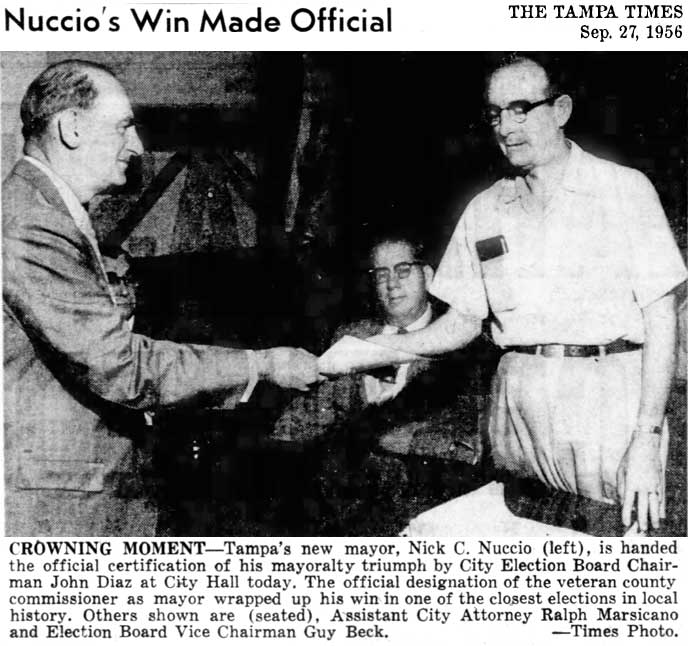 |
ABOUT THAT
COLLECTION AT PLANT PARK THAT "HAD GROWN" SINCE 1937
Now we see that at MOST, the move to
Lowry Park consisted of a 26-year
old gator and a 15-year-old bear.
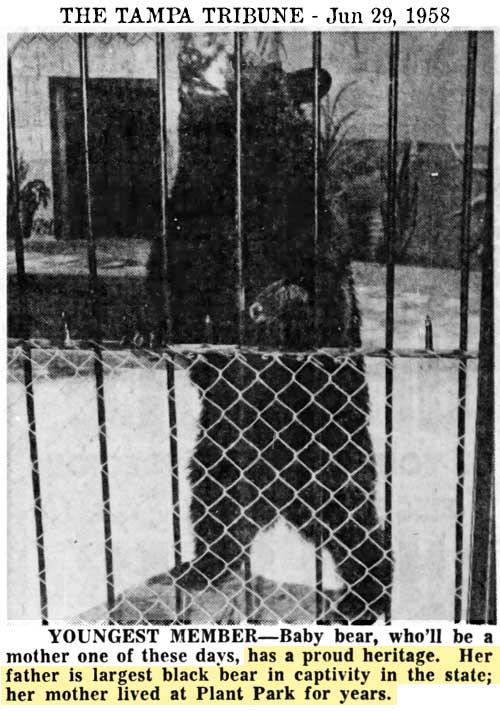 In April, 1957,
Mayor Nuccio announced plans to build a "children's Fairyland" at Lowry
Park, and the first zoo animals would be ones of well-known
storybook fairytales. It would be known as the "Fairyland
Zoo." Mary's little lamb, three "little pigs," Peter
Rabbit(s), etc. So you can eliminate the gator, at least for
1957. What about the
bear? In April, 1957,
Mayor Nuccio announced plans to build a "children's Fairyland" at Lowry
Park, and the first zoo animals would be ones of well-known
storybook fairytales. It would be known as the "Fairyland
Zoo." Mary's little lamb, three "little pigs," Peter
Rabbit(s), etc. So you can eliminate the gator, at least for
1957. What about the
bear?
AT Left: In the summer of 1958 we
learn about some of the first animals acquired for Lowry Park zoo.
The Lowry Park bear was a baby bear, the "Youngest member" of the
zoo. One
who'll be a mother "one of these days." One who "has a proud
heritage. Her father is the largest black bear in captivity in
the state, her mother lived at Plant Park
for years."
MOM NEVER AT PLANT PARK
There were only two female bears ever at Plant Park.
Both were acquired as cubs. Suzie #1 died in 1943 without ever
being mated or having cubs. This event would have made
headlines in the Tampa papers had it happened, and her cub(s)
would have been the subject of a hundred photos.
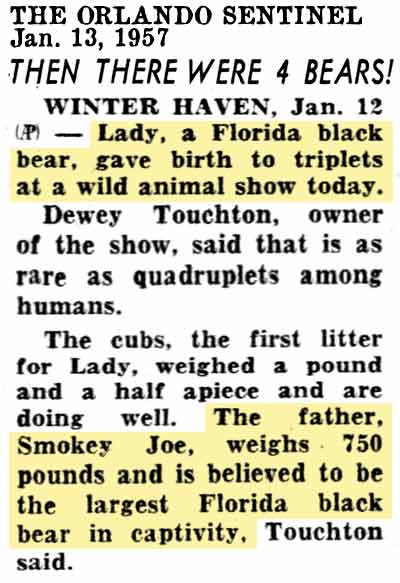 Fatty came after
Suzie #1 in 1943 as a 20-month-old cub. Known as "Susie" or "Paddy" or
"Bruin," and often referred to as a male bear, in 1956 she's a
15-year old recluse who spends most of her time in her Plant Park
cave.
No news was ever announced about her mating or having cubs. If she
did, the story would have made headlines in the Tampa papers, and
her cub(s)
would have been the subject of a hundred photos. Fatty came after
Suzie #1 in 1943 as a 20-month-old cub. Known as "Susie" or "Paddy" or
"Bruin," and often referred to as a male bear, in 1956 she's a
15-year old recluse who spends most of her time in her Plant Park
cave.
No news was ever announced about her mating or having cubs. If she
did, the story would have made headlines in the Tampa papers, and
her cub(s)
would have been the subject of a hundred photos.
Can you imagine a
bear that's been confined for 14 years in the same place, never
having seen another bear, what its reaction would be when introduced
to a giant male bear?
So who were the
parents of this "youngest member," the Lowry Park baby bear?
More than likely they were SMOKEY JOE (a.k.a "Big Joe") and LADY. They had three
cubs born to them on Jan. 12, 1957. "Baby bear" at Lowry Park
was probably one of them. Lady's triplets would have been
around 18 months old in mid-June, 1958. Lady was never at the
Plant Park zoo.
WHATEVER HAPPENED TO
SUSIE #2?
The last bear
living at Plant Park was referred to as "Susie" so often it caused
most everyone forget that she was Susie #2, a female bear who
arrived in 1943 replacing Suzie #1. Plant Park's Susie #2 did get moved to Lowry Park for a short time,
but no sooner than 1955,
and probably in 1957 as the "Plant Park zoo story" goes. The
article below says she died sometime in 1961 at Lowry Park zoo where
she was being cared for.
Susie #2 was
originally known as Fatty during her time in St. Pete. In
Tampa, she was never officially named, and the press called her (and
sometimes "him") Susie, Paddy, and Bruin.
Susie #2
ended up as a
rug on the parks dept. office floor, but nobody dared walk on her. She
suffered enough abuse in her lifetime.
This article is filled with errors because everyone thinks this bear
was the original Susie at Plant Park.

THE
SEVEN NO-NOs of the PLANT PARK BEAR at LOWRY PARK ARTICLE of OCT. 7,
1962
|
1. |
Susie
#2 was NOT the first bear at Plant Park. She was the
THIRD BEAR. "Pat" was the first bear and the only male
bear at Plant Park. He was obtained in Nov. 1933 by Marco Penn
from Ft. Myers to see if the bear could get at a beehive that was
way too high on the University building for anyone to climb or reach.
Pat was around 2 years old at the time. It's not known when he
died. Likely before 1943. |
|
2. |
Susie
#2 was NOT a Florida brown bear, she was a Canadian black bear
obtained by Marco Penn in March 1943 at the age of around 20 months. Penn obtained her from C. W. Bray of Lake Carroll, who had her about
a year. He got her from a St. Pete wild animal zoo when she
was around 8 months old, "and came from Canada." |
|
3. |
Susie #2
was NOT "one of the first animals" at Plant Park.
There were at least 7 alligators, 2 bears, 3 otters, 1
ocelot ("Mexican tiger"), 3 white-nosed coatimundi
(Mexican raccoons, or "ant bears" as the press called
them), a Texas horned toad, and 1 loggerhead turtle
before Susie #2 was acquired. |
|
4. |
Susie #2 was an attraction at Plant Park since March
1943, not since 1937. She was acquired about
10 days after Susie (Suzy) #1 died at Plant Park.
|
|
5. |
Mr.
Boutwell's memory is a bit clouded, he has forgotten that it was the
FIRST Suzy who was a Florida brown bear captured in a
tree in the Everglades by Marco Penn. |
|
6. |
If Susie
#2 was ever exposed to a male bear, it would have been
Pat, the first bear at Plant Park. But after
1936, he's never mentioned by name again.
References to a plurality of bears at Plant Park ends in
Dec. 1938. After that, all articles reference only
a single bear. When Suzy #1 died in Mar. 1943, no
other bear is mentioned, and she is referred to as "the
bear" and NOT "one of the bears." Likewise, when
Susie #2 is acquired 10 days later, nothing is said of
another bear or how they would get along with each other
as you would expect. So Pat, the only male bear
ever at Plant Park, may have died or been removed before
Susie #2 ever arrived.
There were
three bear bite/clawing incidents in 1939 to 1940.
In all of the articles, the bear is referred to in
singular, instead of "one of the bears." The last
article mentioning Pat was in Feb. 1938, so these three
1939 incidents may have involved Suzy #1. |
|
7. |
Susie #2
was an attraction in Tampa from 1943 to around 1961.
This is 18 years, not 25 years. |
OBITUARY OF ELSIE MAY
PENN, WIFE OF MARCO PENN SR.
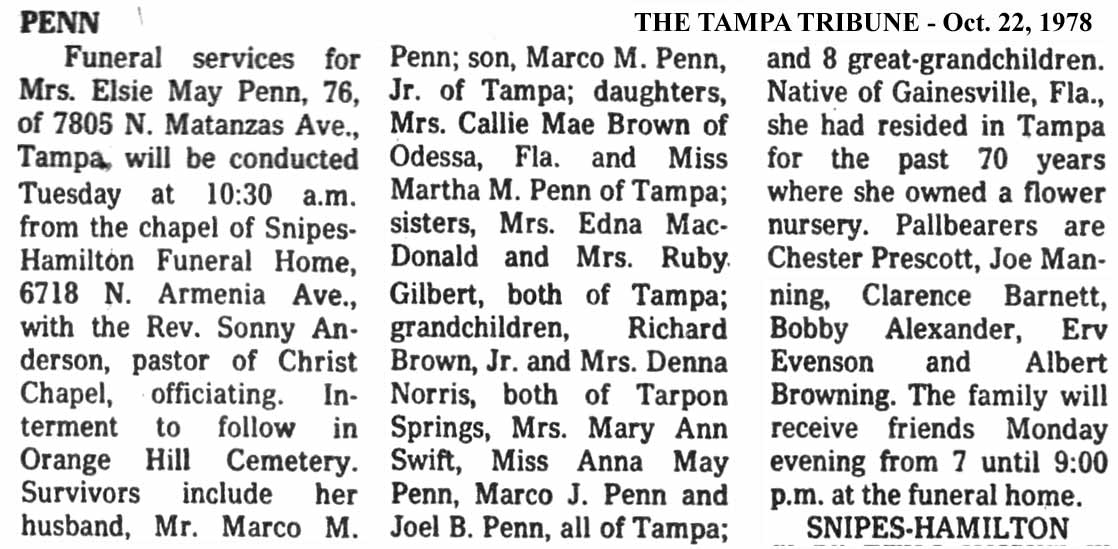
MARCO PENN FIT AS A FIDDLE
AT 83
He credits Sulphur Springs
mineral water for his good health. Plenty of hard work as parks
supt. and at his landscaping business surely also played a significant
role.
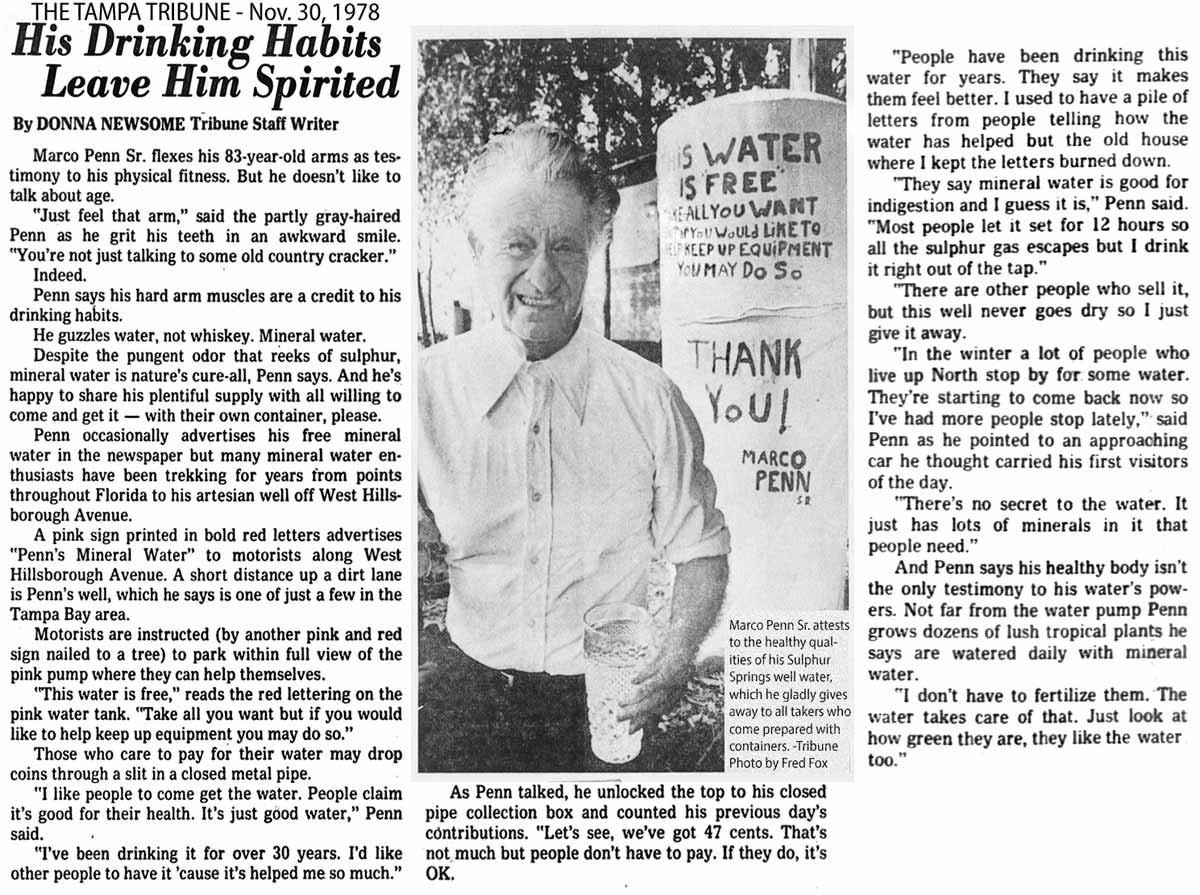
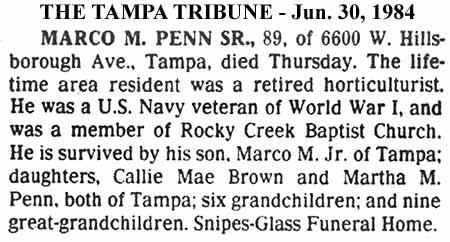
Marco M. Penn, Sr. died on
June 28, 1984 in Tampa. He was 89.
Lowry Park
Beginnings
The
Courthouse Fountain & Sulphur Springs zoos
Plant Park Zoo
Boyd's Sunoco Zoo
Fairyland
Fairyland/Lowry Park Zoo
Sheena
the Baby Elephant & Jim Godfrey
Herman - King of the Zoo
Safety Village / Children's Museum /
Kids City
Dr. Bragg's Fantasia Golf
Saving Fairyland!
Zoo
1
2 3
4
5
|


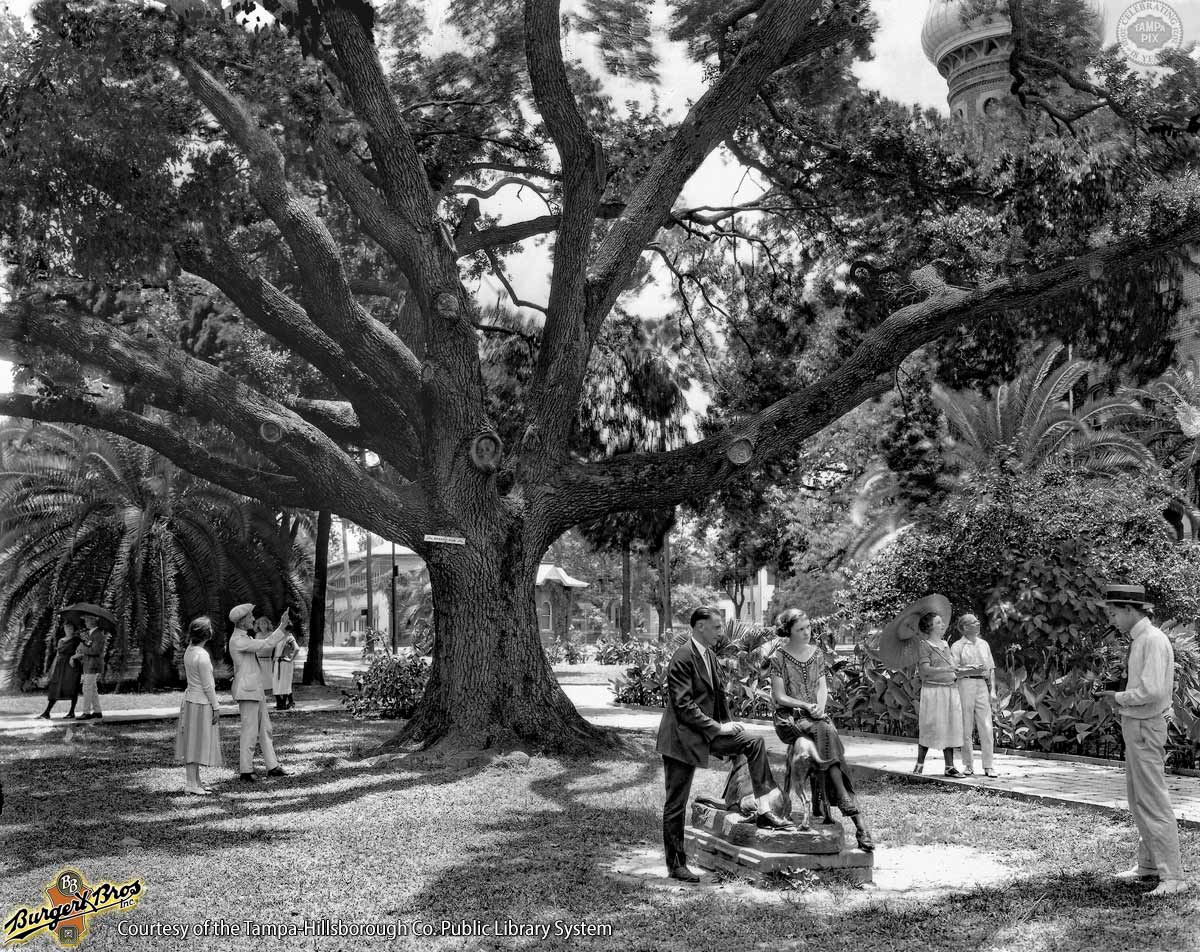
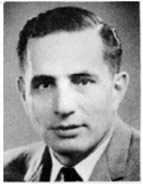

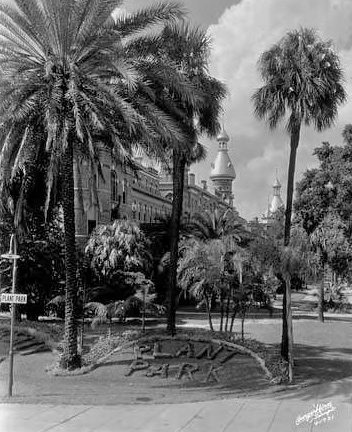
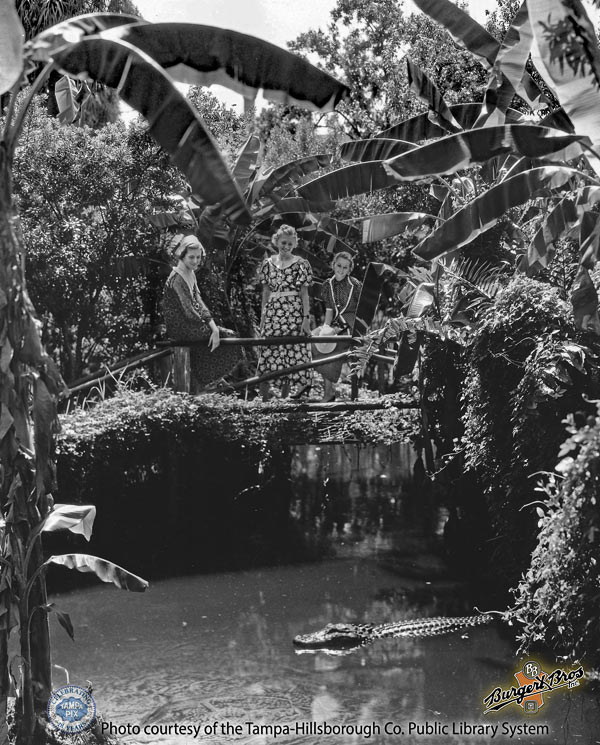
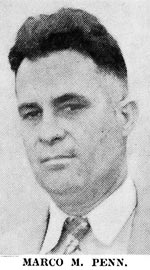
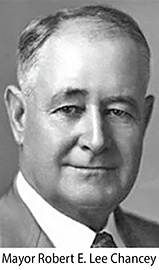 The nucleus of
what would become referred to as the "Tampa City Zoo" or "Plant Park Zoo"
as
"started by city employees" was in fact started by
Parks
Dept. Superintendent Marco Penn with a small collection of alligators
captured in the area or which swam up the creek at Plant
Park from the river, as well as the gators and small turtles sent there
from the
The nucleus of
what would become referred to as the "Tampa City Zoo" or "Plant Park Zoo"
as
"started by city employees" was in fact started by
Parks
Dept. Superintendent Marco Penn with a small collection of alligators
captured in the area or which swam up the creek at Plant
Park from the river, as well as the gators and small turtles sent there
from the 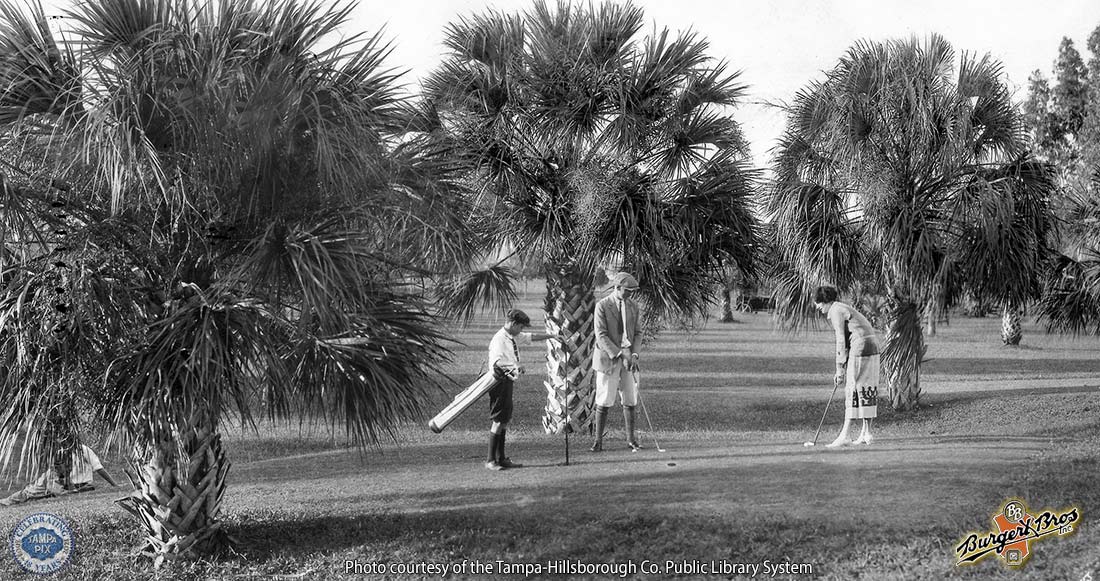
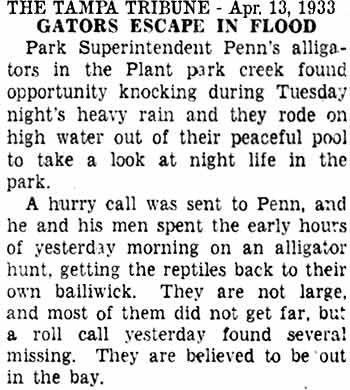
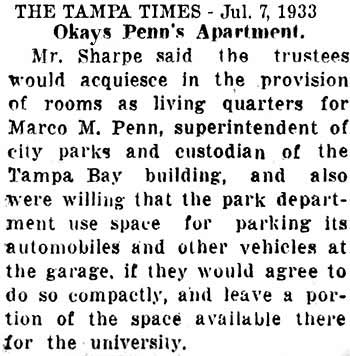
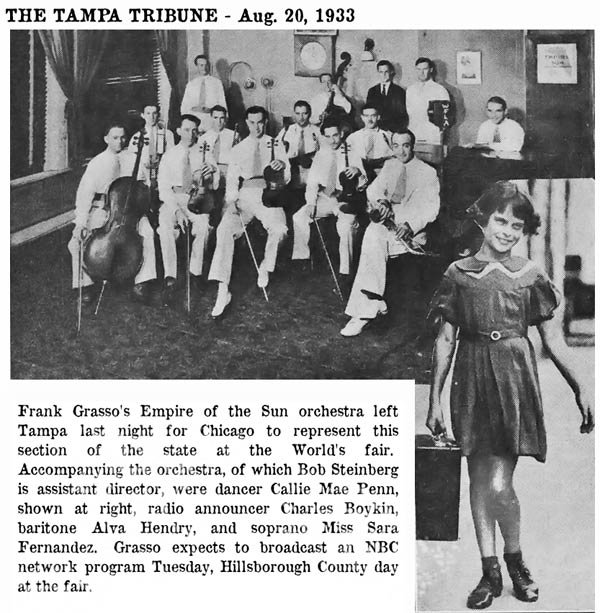
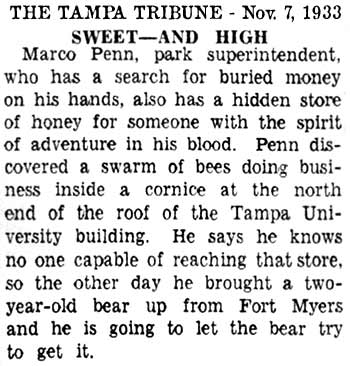
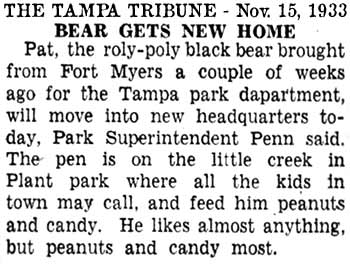
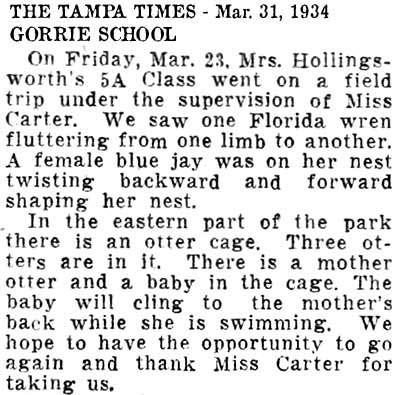
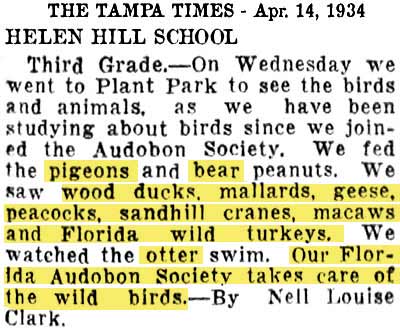
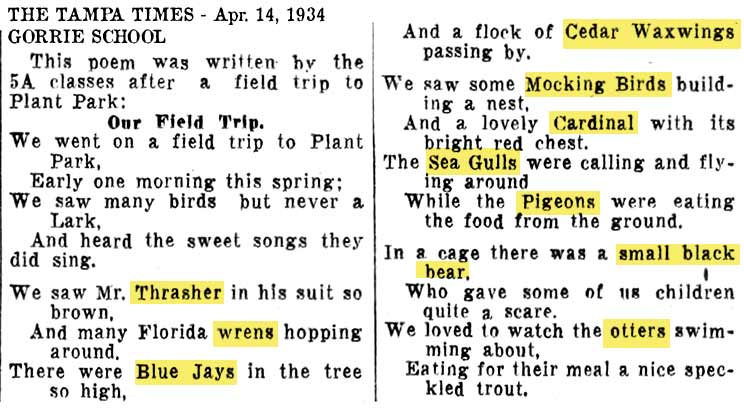
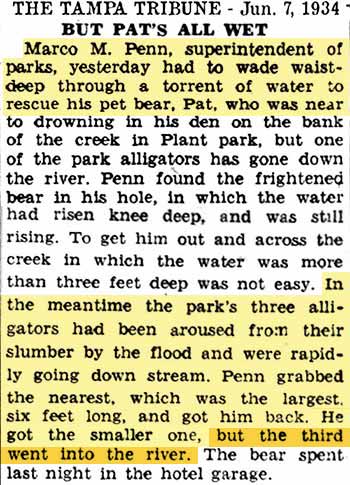
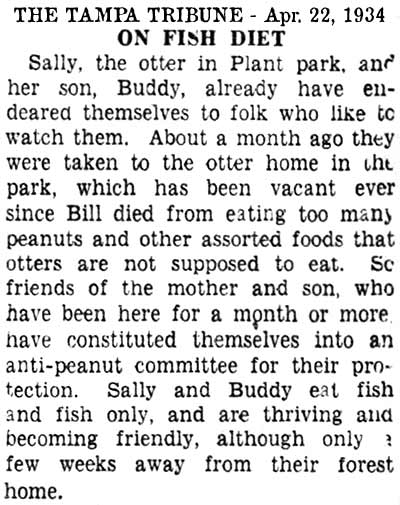
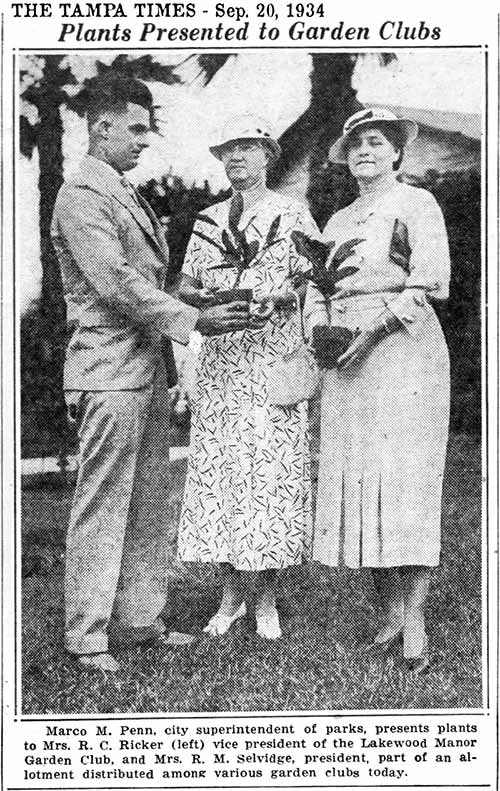
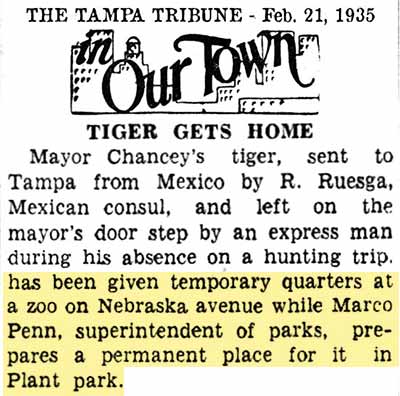

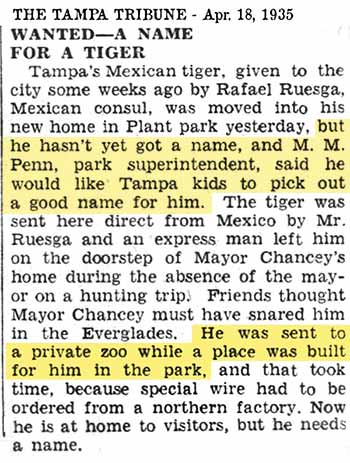
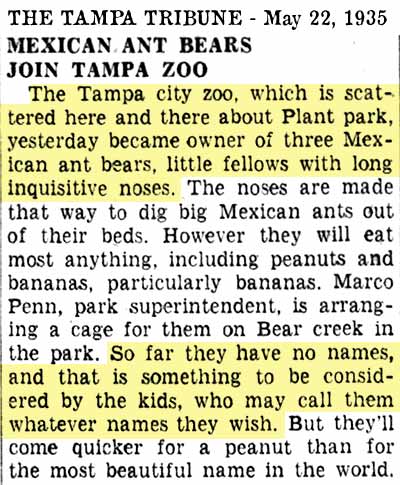
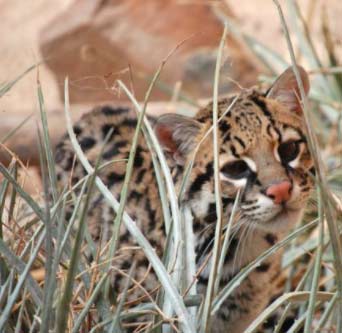
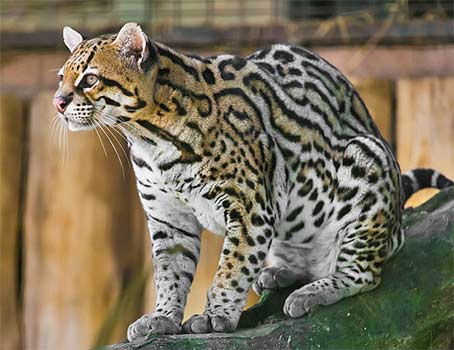
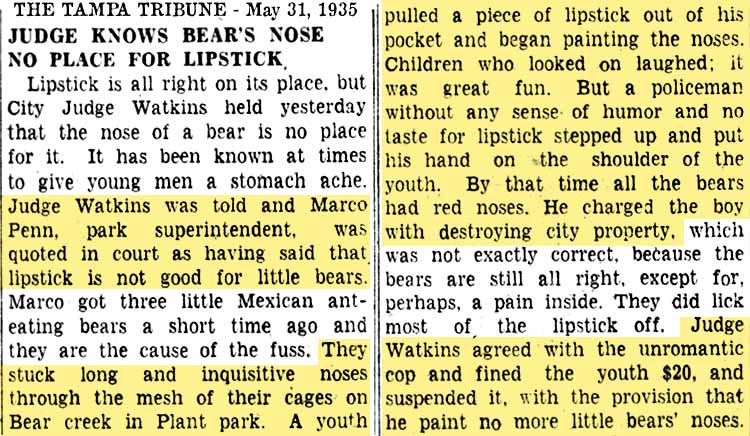
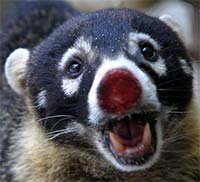 A
little over a week after the "Mexican ant bears" arrived, they
were subject to abuse by a boy who thought it would be great fun to
paint their noses with red lipstick.
A
little over a week after the "Mexican ant bears" arrived, they
were subject to abuse by a boy who thought it would be great fun to
paint their noses with red lipstick.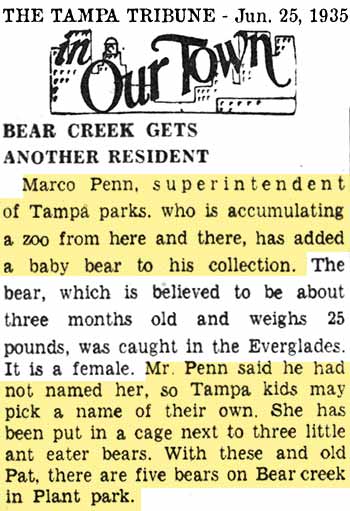
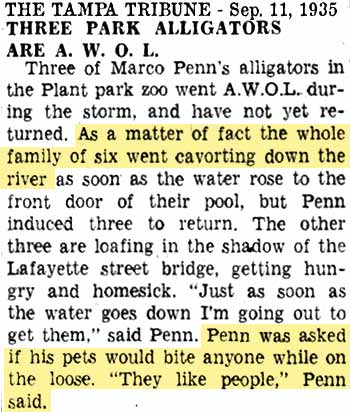
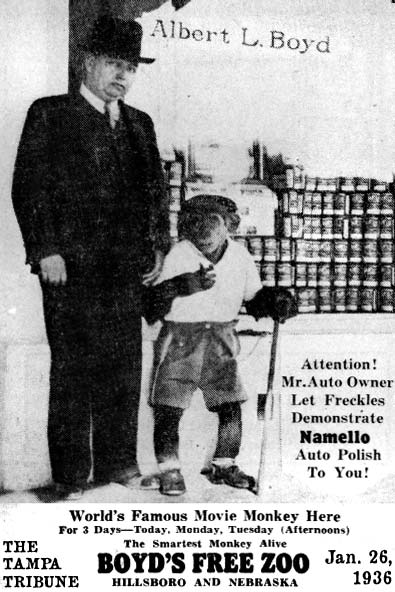

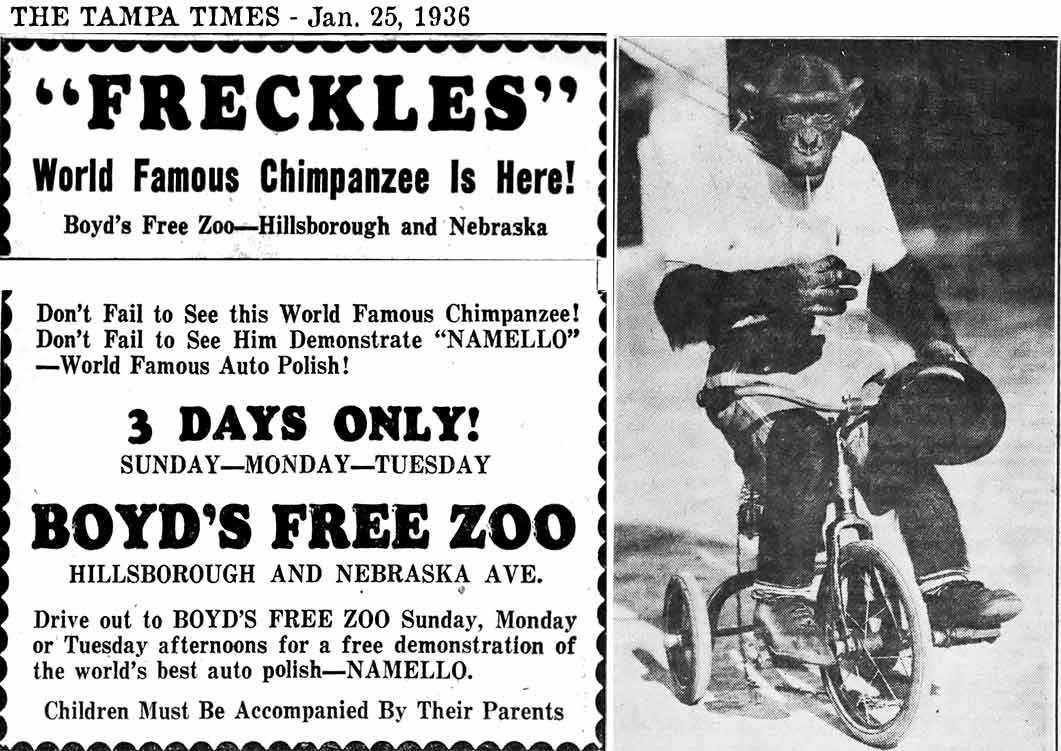
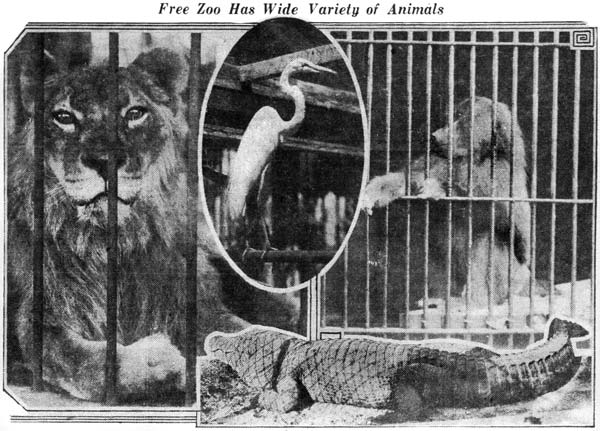
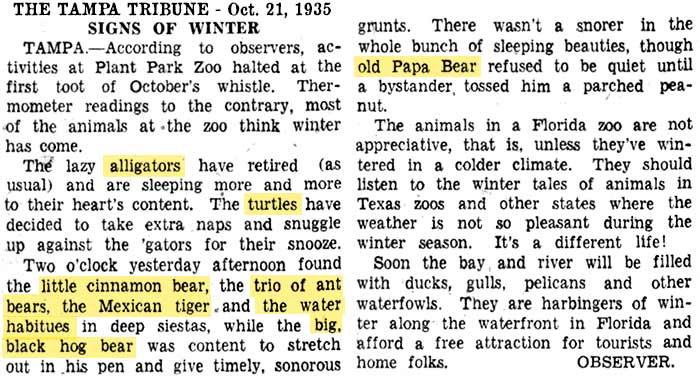
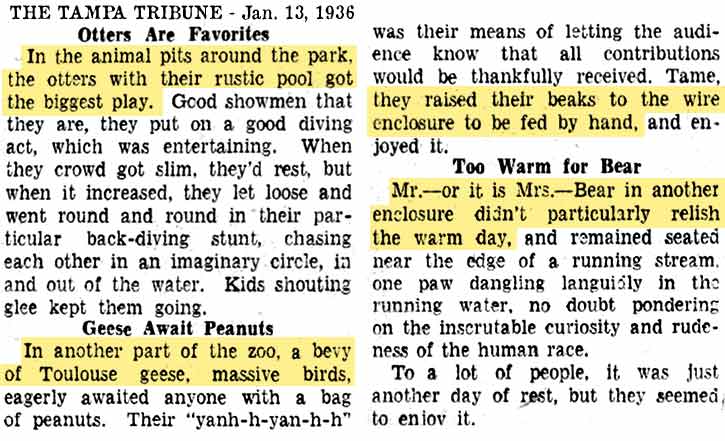
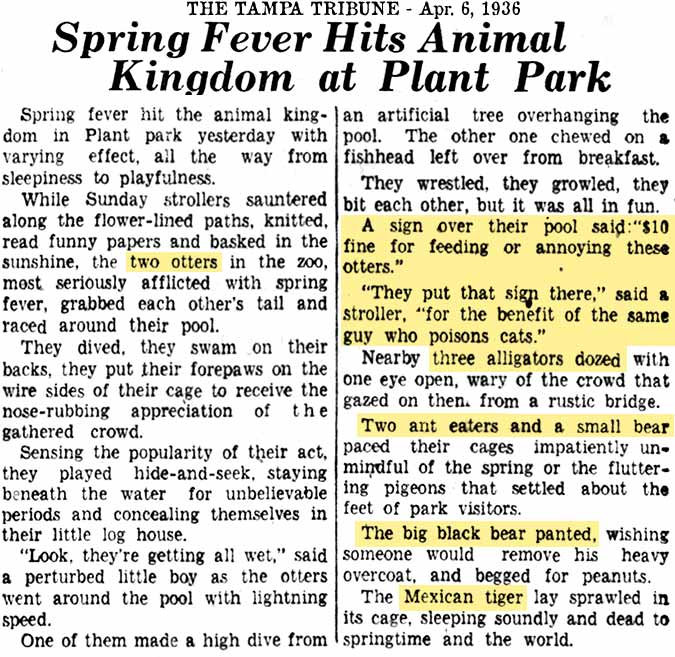
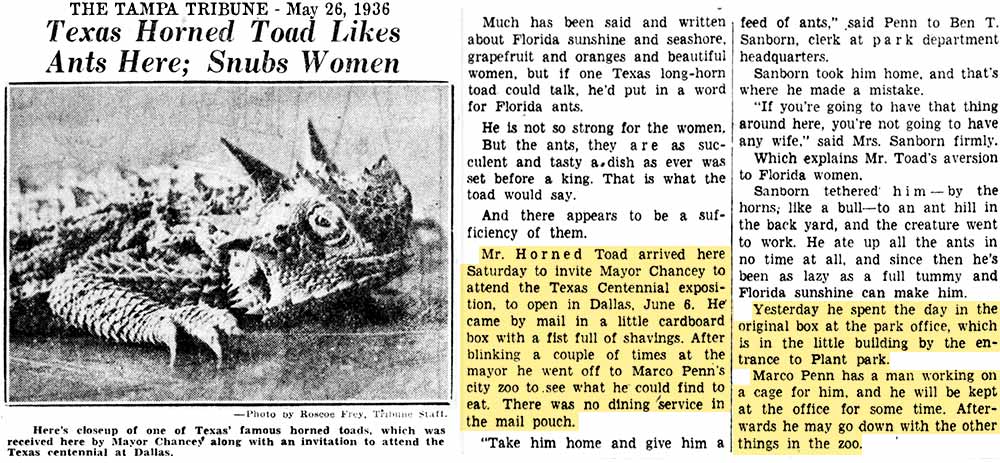
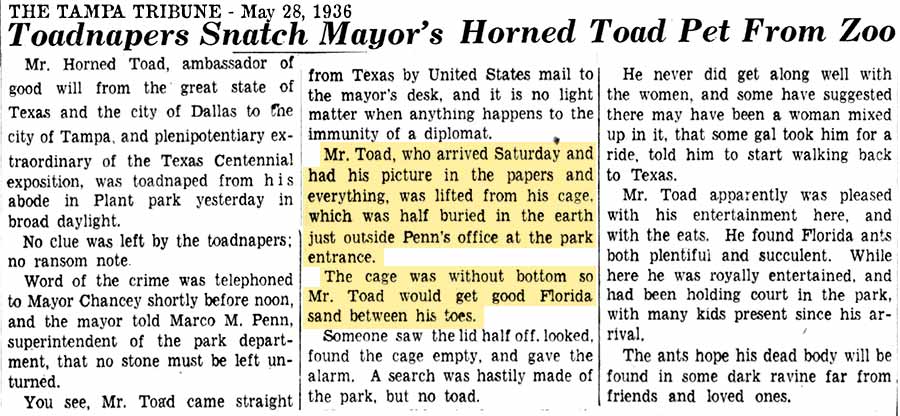
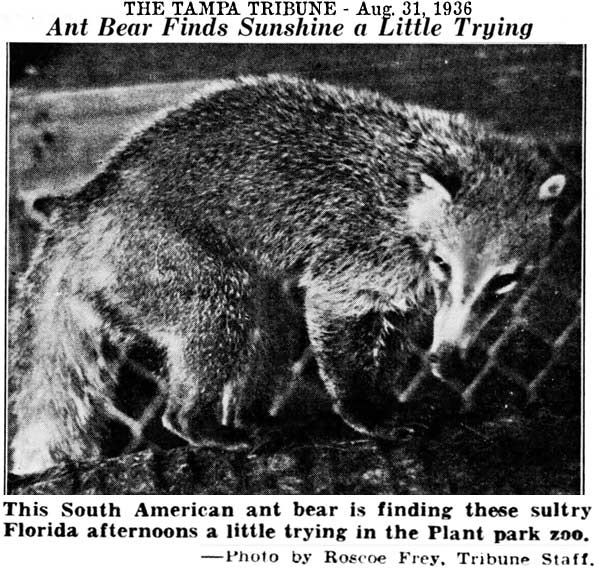
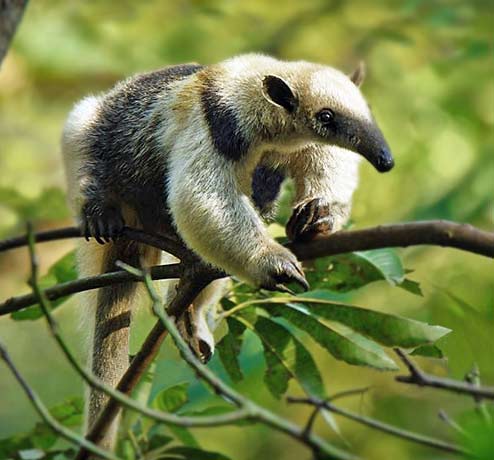 As
you can see, the above creature is not an anteater. The
anteaters native to southern Mexico and northern South America are Tamandua, two species anteaters that live in
grassland and forest. The Mexicana Tamanduas anteater is much smaller than giant anteaters. They
have a prehensile tail, small eyes and ears, and a long curved snout,
shaped much like the end of a banana.
The fur is pale yellow over most of the body, with a distinctive
patch of black fur over the flanks, back, and shoulders, that
looks like it's wearing a vest. The presence of this color
pattern makes it possible to distinguish this species from its
southern relative, which has a more uniform color. The
tail has fur on its upper surface for about a third of its
length, but is otherwise hairless. The hind feet have five toes,
while the fore feet have only four. Males and females are
similar in size and color, and range from 40 to 51 inches in
total length, including the 16 to 27 inch tail. Adults weigh
between 7 to 12 lbs. It has
unusually well developed muscles, attached to a large hyoid bone
and rooted to the top of the sternum. The entire oral cavity is
modified to accommodate this tongue, and is so elongated that
the back of the soft palate is level with the fifth cervical
vertebra near the base of the neck, rather than at the top of
the pharynx as in most other mammals. The jaw muscles and
mandible are reduced, and the latter is particularly fragile.
Like other anteaters, the northern tamandua has no teeth. The
muscles of the toes and the presence of a tough pad on the palms
makes the forefeet prehensile, enabling them to grip onto
projections as it climbs. The middle toe of the forefeet also
bears an unusually large claw, and the toe has enough muscle and
leverage to allow it to rip open wood to get at the ants within.
As
you can see, the above creature is not an anteater. The
anteaters native to southern Mexico and northern South America are Tamandua, two species anteaters that live in
grassland and forest. The Mexicana Tamanduas anteater is much smaller than giant anteaters. They
have a prehensile tail, small eyes and ears, and a long curved snout,
shaped much like the end of a banana.
The fur is pale yellow over most of the body, with a distinctive
patch of black fur over the flanks, back, and shoulders, that
looks like it's wearing a vest. The presence of this color
pattern makes it possible to distinguish this species from its
southern relative, which has a more uniform color. The
tail has fur on its upper surface for about a third of its
length, but is otherwise hairless. The hind feet have five toes,
while the fore feet have only four. Males and females are
similar in size and color, and range from 40 to 51 inches in
total length, including the 16 to 27 inch tail. Adults weigh
between 7 to 12 lbs. It has
unusually well developed muscles, attached to a large hyoid bone
and rooted to the top of the sternum. The entire oral cavity is
modified to accommodate this tongue, and is so elongated that
the back of the soft palate is level with the fifth cervical
vertebra near the base of the neck, rather than at the top of
the pharynx as in most other mammals. The jaw muscles and
mandible are reduced, and the latter is particularly fragile.
Like other anteaters, the northern tamandua has no teeth. The
muscles of the toes and the presence of a tough pad on the palms
makes the forefeet prehensile, enabling them to grip onto
projections as it climbs. The middle toe of the forefeet also
bears an unusually large claw, and the toe has enough muscle and
leverage to allow it to rip open wood to get at the ants within.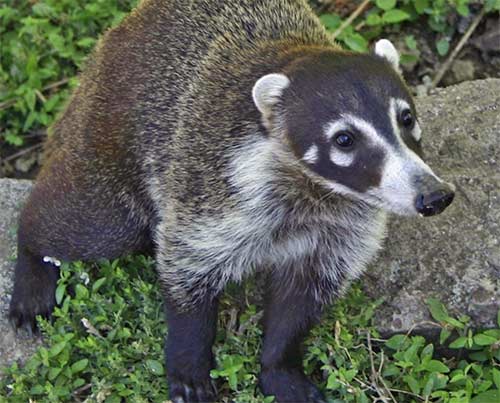 The
"Mexican ant bears" at Plant Park, judging by the newspaper photo, were
"Mexican raccoons," or "Snookum bears" or a host of many other
regional
nicknames, but officially known as Coati, or Coatimundi. There
are four species of coati, the South American, found in both Central and
South America, the eastern mountain, found in Venezuela, the western
mountain, found in Ecuador and Columbia, and finally the
white-nosed Coatimundi. The white-nosed coati is the species most often referred
to as a Mexican raccoon, because it ranges across Central America,
Mexico, and the Southwestern United States.
The
"Mexican ant bears" at Plant Park, judging by the newspaper photo, were
"Mexican raccoons," or "Snookum bears" or a host of many other
regional
nicknames, but officially known as Coati, or Coatimundi. There
are four species of coati, the South American, found in both Central and
South America, the eastern mountain, found in Venezuela, the western
mountain, found in Ecuador and Columbia, and finally the
white-nosed Coatimundi. The white-nosed coati is the species most often referred
to as a Mexican raccoon, because it ranges across Central America,
Mexico, and the Southwestern United States. Mexican raccoons are highly intelligent animals about the size of a very
big house cat. They have mask-like coloration on the face, and rings
around their tails, and are members of the family procyonidae, along
with raccoons, kinkajous and ring-tailed cats. They live in very active
groups of up to forty individuals, and spend most of their time foraging
on the ground, although they nest and sleep in trees. They are highly
social, playful and affectionate with each other, and keep in contact
with a variety of whistles, squeals, chatters and snorts.
Mexican raccoons are highly intelligent animals about the size of a very
big house cat. They have mask-like coloration on the face, and rings
around their tails, and are members of the family procyonidae, along
with raccoons, kinkajous and ring-tailed cats. They live in very active
groups of up to forty individuals, and spend most of their time foraging
on the ground, although they nest and sleep in trees. They are highly
social, playful and affectionate with each other, and keep in contact
with a variety of whistles, squeals, chatters and snorts.
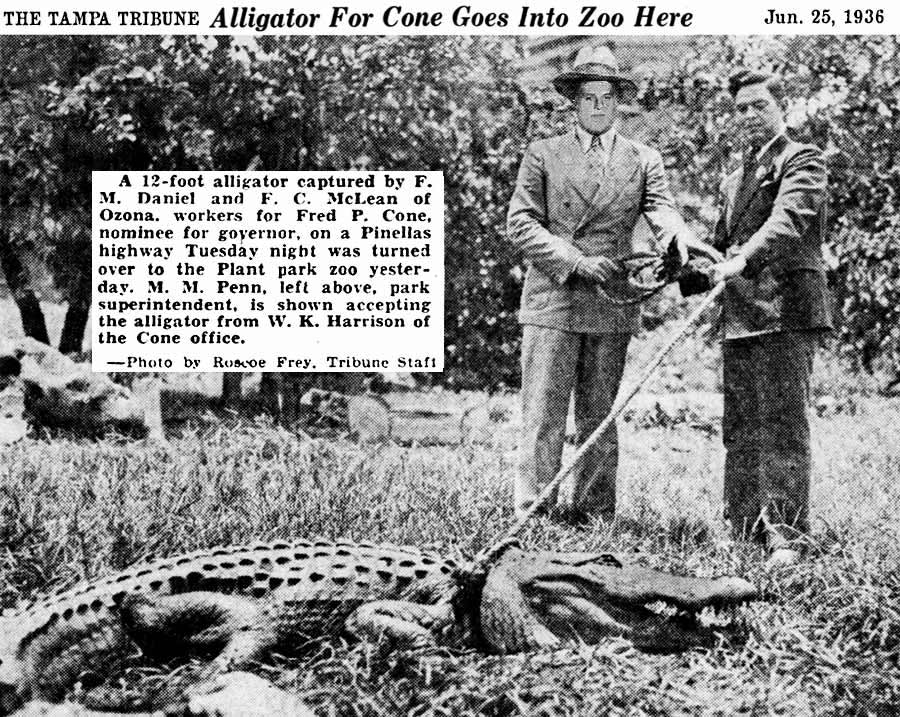
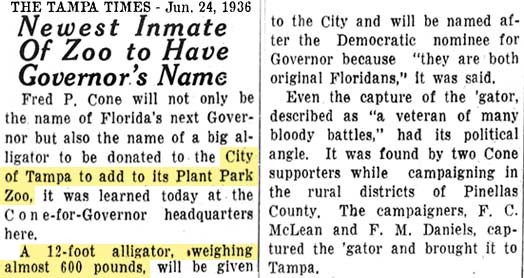
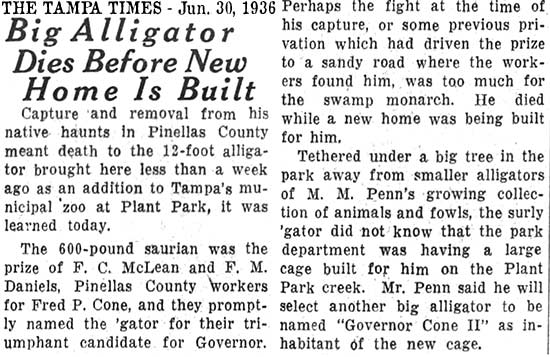
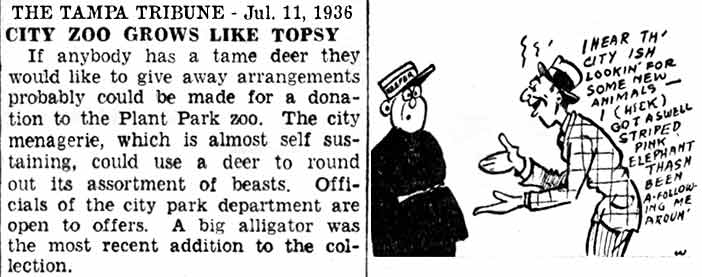
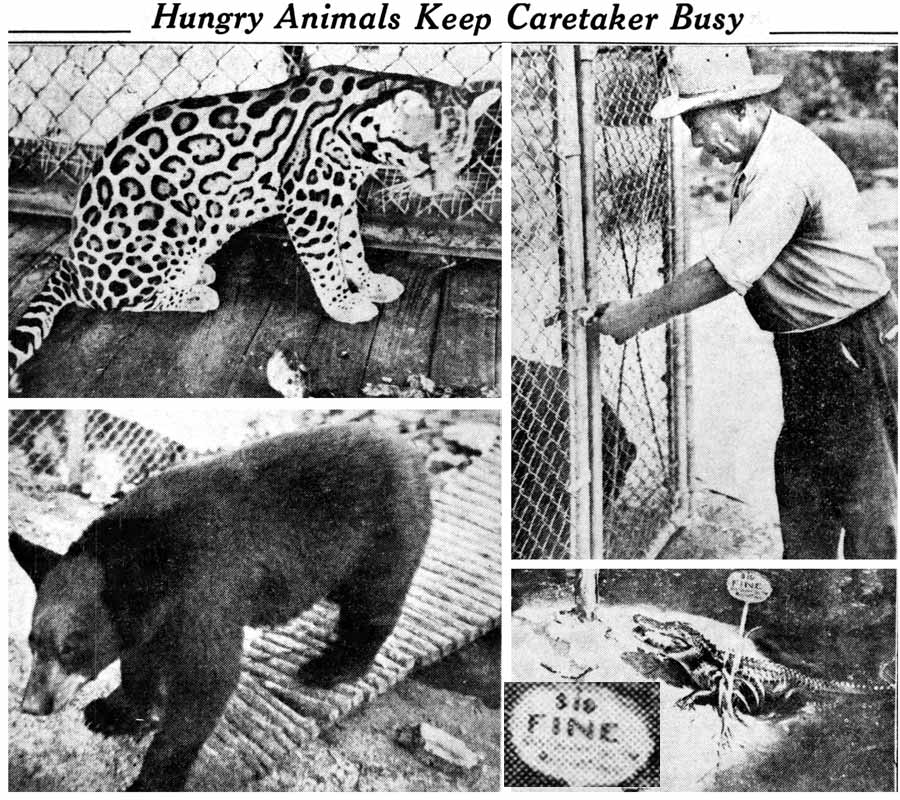

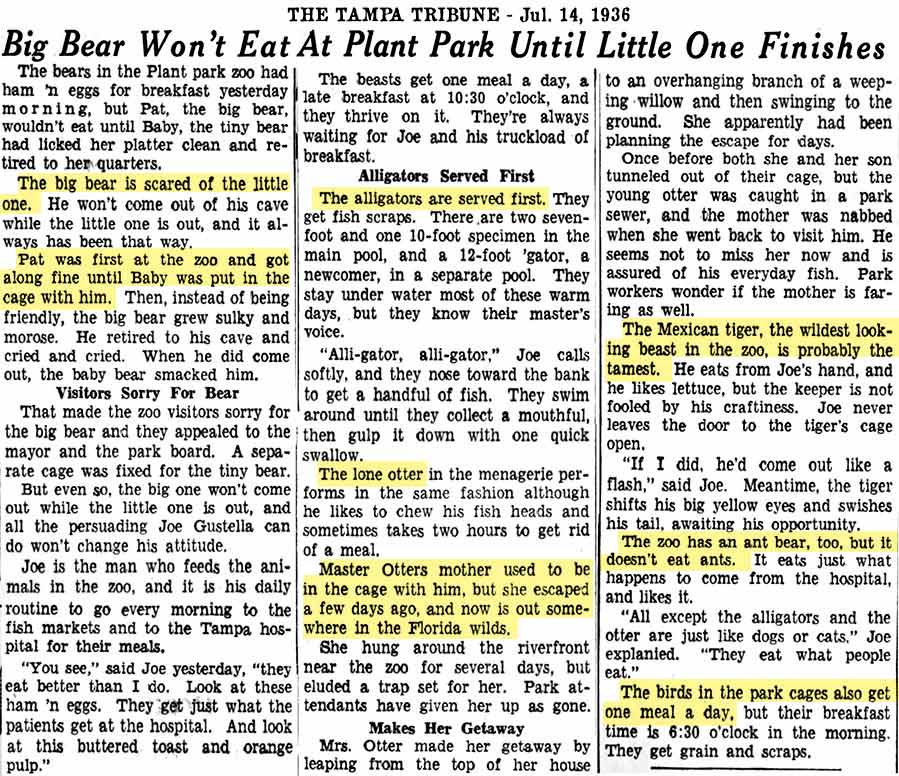

































 At right, a
tourist comments on the death of "the bear in Plant
Park" and hopes that the next bear will be given a
better habitat; one with a "large stone basin, where it
can bathe itself and keep cool in the summer," instead
of a "dirty little creek." Also, "a place large enough
to get some exercise" and something to climb upon, "as
all bears love to do." Also, the ground kept with clean
gravel so it wouldn't smell so bad and "be a pleasure to
have it there."
At right, a
tourist comments on the death of "the bear in Plant
Park" and hopes that the next bear will be given a
better habitat; one with a "large stone basin, where it
can bathe itself and keep cool in the summer," instead
of a "dirty little creek." Also, "a place large enough
to get some exercise" and something to climb upon, "as
all bears love to do." Also, the ground kept with clean
gravel so it wouldn't smell so bad and "be a pleasure to
have it there."


































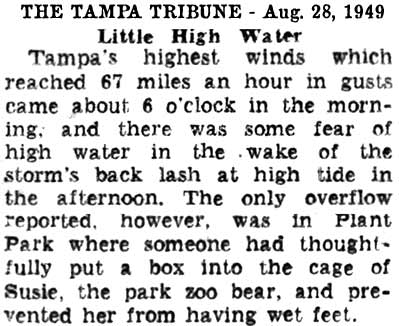



.jpg)
















